EVERYTHING CRASH
EDDIE CHAMBERS
EXTRACT FROM Things Done Change
DATE 2012
SOURCE Courtesy of the Author

EXTRACT FROM Things Done Change
DATE 2012
SOURCE Courtesy of the Author
[Okwui] Enwezor tells us that he flew all over God's earth looking for artists to include In the exhibition, hut evidence of genuineresearchis hard to ascertain, because Enwezor's selection (and that of his [Octavio] Zaya his co-curator) is quite a lazy one Take for example the London contingent, which includes the likesof Yinka Shonibare,Steve McQueen,IsaacJulien,Vong Phaophanit Sam Taylor-Wood and Mark Wallinger These are all accomplished and successful artists whose work is already doing the rounds If these British artists were Enwezor's most original selection,that gives you some idea about therestof theexhibition andthe international artists represented in it?
THUS FAR, NO MOMENT IN RECENT HISTORY has comc closc to replicating anything like the broad range of exhibition acfivity involving Black artists in the iqSos.^ (To some extent, the initiatives of artists and activists themselves must be differentiated from a more insfitutionai embrace of Black artists during the decade.) More tellingly, there has been little to nothing of the drive, energy, and inventiveness with which artists and activists pursued their own visions and their own agendas When Shakka Dedi and other like-minded individuals set up the Black-Art Gallery, via their organization, OBAALA, they did so in ways that were decidedly proacfive

' "Everything Crash," a popular reggae song by I'he Ethiopians, was released in Jamaica in 1968. I'he song bemoaned the political paralysis and widespread labour unrest of thetime Most significantly perhaps,the stmg lamented the fioundcring of the hopesand dreams of independence,which had beenushered injust afew yearsearlier. Sorrowfully, the songreiteratedthe Jamaican proverb 'What gone bad amomin" can't comegixxl a evenin".
^Eddie Chambers "Johannesburg: A Review of the Second Johannesburg Bicnnale," Art Monthly 212(December 1997-January 1998):17
^ Fordi.scussionof this activity, see Eddie Chambers,"Black Visual Arts Acfivity In England 1981-1986: Pressand Public Responses."
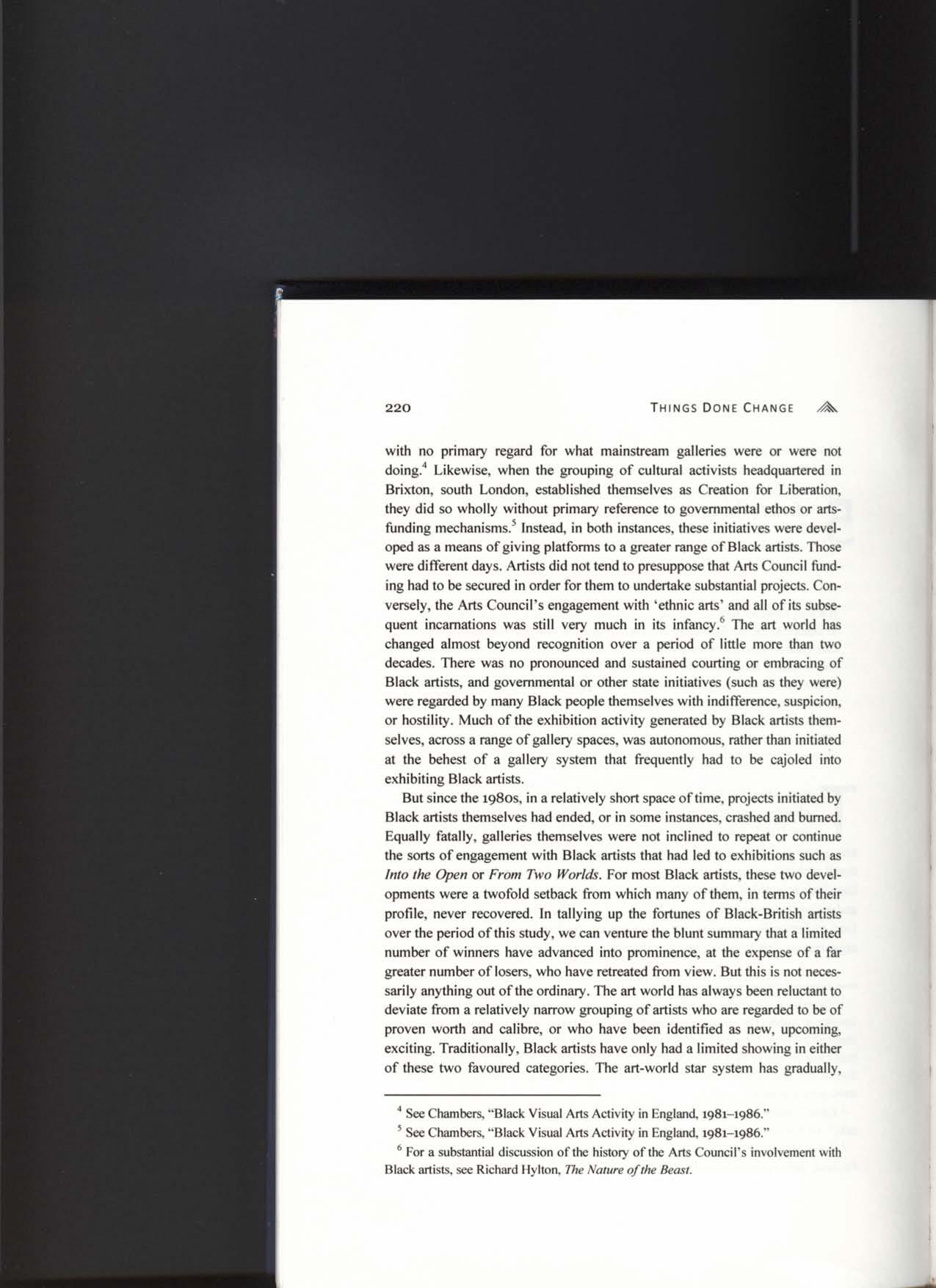
with no primary regard for what mainstream galleries were or were not doing."* Likewise, when the grouping of cultural activists headquartered in Brixton, south London, established themselves as Creation for Liherafion, they did so wholly without primary reference to governmental ethos or artsftjnding mechanisms? Instead, in both instances, these inifiatives were developed as a means of giving platfonns to a greater range of Black artists Those were diflferent days. Artists did not tend to presuppose that Arts Council funding had to be secured in order for them to undertake substantial projects Conversely, the Arts Council's engagement with 'ethnic arts' and all of its subsequent incarnations was still very much in its infancy.^ The art world has changed almost beyond recognition over a period of little more than two decades There was no pronounced and sustained courting or embracing of Black artists, and governmental or other state inifiatives (such as they were) were regarded by many Black people themselves with indift'erence, suspicion, or hostility Much of the exhibition activity generated by Black artists themselves, across a range of gallery spaces, was autonomous, rather than initiated at the behest of a gallery system that frequently had to be cajoled into exhibiting Black artists
But since the 1980s, in arelatively short space of time, projects initiated by Black artists themselves had ended, or in some instances, crashed and bumed. Equally fatally, galleries themselves were not inclined to repeat or confinue the sorts of engagement with Black artists that had led to exhibifions such as Into the Open or From Tsvo Worlds. For most Black artists, these two developments were a twofold setback from which many of them, in tenns of their profile, never recovered In tallying up the fortunes of Black-British artists over the period of this study, we can venture the blunt summary that a limited number of winners have advanced into prominence, at the expense of a far greater number of losers, who have retreated from view But this is not necessarily anything out of the ordinary. The art world has always been reluctant to deviate from a relatively narrow grouping of artists who are regarded to be of proven worth and calibre, or who have been identified as new, upcoming, exciting. Traditionally, Black artists have only had a limited showing in either of these two favoured categories The art-world star system has gradually,
•*SeeChambers,"Black Visual Arts Activity in England. 1981-1986."
' SeeChambers,"Black Visual Arts Activity in England, 1981-1986."
* For a substantial discussion ofthc history ofthc Arts Council's involvement with Black artists,seeRichard 1 lylton The Nature of the Beast,

over a period of several decades, become hegemonic and (the fortunes of the likes of McQueen, Ofili, and Shonibare aside), this system has ultimately disadvantaged the majority of Black artists, curtailing their chances of achieving significant career success. One of the most important reasons for this is the way in which there has been a discernible convergence of curatorial agendas among the country's art galleries In the period of the late 1970s and early 1980s, there was a wide range of visual arts venues, which were - despite the generally poor profile of Black artists in these galleries - exhibiting a similarly broad span of artists' pracfice The extent of arts spaces included municipal and local-authority galleries, which were frequently adjacent to, or housed in, museum or library buildings in town and city centres; arts centres, in which audiences could access such art forms as theatre, dance, music, and poetry, alongside the visual arts; independent art galleries that tended not to be under the direct control of either local authorifies or nafional and regional fijnding bodies; university and polytechnic art galleries; gallery spaces in artists' studios; and, in London, there were also both the national galleries and the private gallery sector To some extent this plurality reflected or covered different artists, different audiences, and different types of media outlet
Over time, however, these gallery spaces have converged and coalesced around a much more limited range of the same artists. These art spaces were in many ways reflected in the range of professionals or semi-professionals charged with mounting exhibitions there - again despite the generally poor prospects of Black people who might seek employment in these venues. From university-trained keepers of art who worked in city museums and galleries, through to librarians and others whose jobs included looking after gallery spaces in libraries and arts centres; from art-school tutors who looked after their college's gallery spaces, through to artists and other practitioners who had morphed into gallery directors - there was a discernible plurality of arts personnel, reflecfing the plurality of galleries. Again over time, and again with little exception, this range of personnel has clustered around a much more limited range of like-minded people who now invariably refer to themselves as curators. Here we have to recognizee the 'professionalizing' of the visual arts and the ways in which the proliferation of curating courses has detrimentally narrowed the range of preferences and sensibilifies among gallery staff. As Tony Godfrey has noted,
Broadly speaking, since 1979 it seems that the art world has changed from something like agentleman's club to awebsite andthat the largegroup show

has been transformed from an anthology to an argument. Most generally, we sec a shift from patronage to curatorship - symptomatically the selectors of The British Art Show 5 arc for the first time called, by their preference, curators.*'
In a footnote to this, Godfrey states:
The rise of the curator, someone who organizes exhibitions as their profession, is a key development in the last twentx-five years. Ii is symptomatic that the selector of Tlie British Art Show 1 was a critic and that two of the three 'selectors' of The British Art Show 5 should describe themselves,wholly or in part, as freelance curators. A defining moment in the professionalization of the curator in Britain was the founding in 1992 ofthc Royal Collegeof Art MA in Visual Arts Administration: Curafing and Commissioning Contemponuy Art.
Although possibly unintended, these changes tended to limit, rather than foster, the plurality through which Black artists of the 1980s sought and gained exhibition exposure The galleries of the country have by and large pursued the same 'white cube' aesthetic and, in a kind of systemic feedback, are now run by the same sorts of people, who tend to congregate curatorially around the same sorts of artist With few exceptions, Black-British artists are clear losers in these changes. Worse still, the dominant cultural, political, and intellectual climate seems largely unconducive to the emergence of new generations of Black artists, outside of existing ftrameworks, structures, and pathologies From different quarters we have witnessed the stacking-up of formidable factors that have historicized earlier generations of Black-British artists and militated against repefition of their group-level successes. We need also to consider that, despite the relafively increased academic attention being paid to Black artists in recent years, no moment in recent history has come close to generating anything like the variety of argument, opinion, and debate that circulated around exhibition acfivity involving Black artists in the 1980s.'
With regard to the 1980s, several cautionary notes should be struck Mainstream gallery activity involving Black artists sometimes came across as
' Tony Godfrey, "British Art and the British Art Show 1976-2000." in The British Art Show 5 (exh. cat.; London: National Touring Exhibitions, South Bank Centre, 2000): 20.
' Godfrey. "British Art and the British Art Show 1976-2000."31
' See Chambers. "Black Visual Arts Activity In England, 1981-1986."esp.Chapter Two, "Black Art; For and Against."
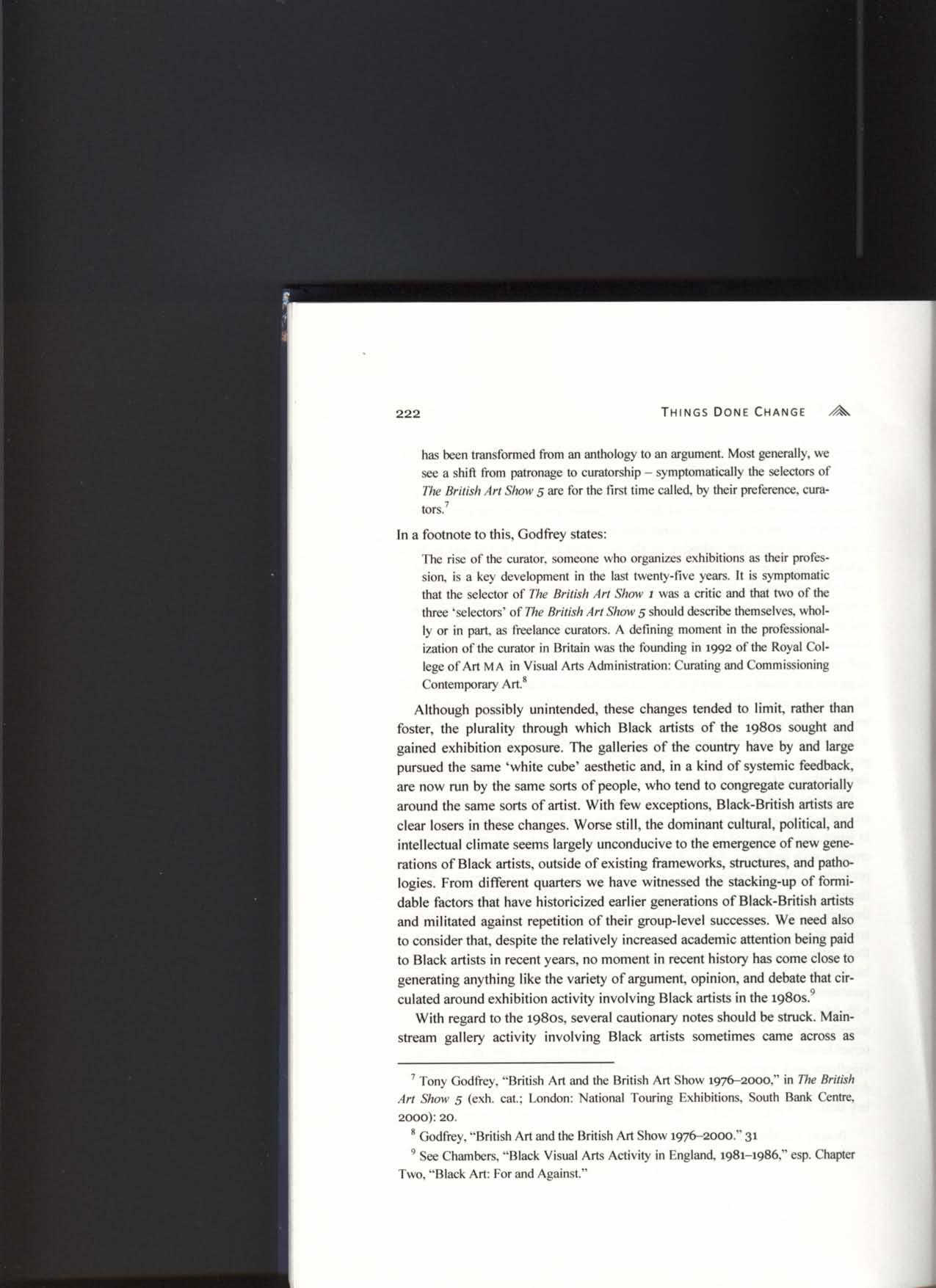
has beentransformed from an anthology to an argument. Most generally, we see a shift from patronage to curatorship - symptomatically the selectors of TIte British Art Show 5 are for the first time called, by their preference,curators.'
In a footnote to this, Godfrey states:
The rise of the curator, someone who organizes exhibitions as their profession, is a key development in the last twenty-five years It is symptomatic that the selector of Hie British Art Show 1 was a critic and that Uvo of the three "selectors' of The British Art Show 5 should describe themselves,wholly or in part, as freelance curators A defining moment in the professionalization of the curator in Britain was the founding in 1992 of the Royal Collegeof Art MA in Visual Arts Administration: Curating and Commissioning Contemporary Art.'
Although possibly unintended, these changes tended to limit, rather than foster, the plurality through which Black artists of the 1980s sought and gained exhibition exposure. The galleries of the country have by and large pursued the same 'white cube' aesthetic and, in a kind of systemic feedback, are now run by the same sorts of people, who tend to congregate curatorially around the same sorts of artist. With few exceptions, Black-British artists are clear losers in these changes Worse still, the dominant cultural, political, and intellectual climate seems largely unconducive to the emergence of new generafions of Black artists, outside of existing frameworks, structures, and pathologies From different quarters we have witnessed the stacking-up of fomiidable factors that have historicized earlier generations of Black-British artists and militated against repetition of their group-level successes We need also to consider that, despite the relafively increased academic attenfion being paid to Black artists in recent years, no moment in recent history has come close to generating anything like the variety of argument, opinion, and debate that circulated around exhibifion acfivity involving Black artists in the 1980s.'
With regard to the 1980s, several cautionary notes should be stnjck. Mainstream gallery activity involving Black artists somefimes came across as
' I'ony Godfrey, "British Art and the British Art Show 1976-2000," in The British An Show 5 (cxh, cat.; London: National Touring Exhibitions, South Bank Centre, 2000): 20.
' Godfrey,"British Art andthe British Art Show 1976-2000." 31
' SeeChambers "Black Visual Arts Activity in England 1981-1986," esp Chapter Two, "Black Art: For andAgainst."
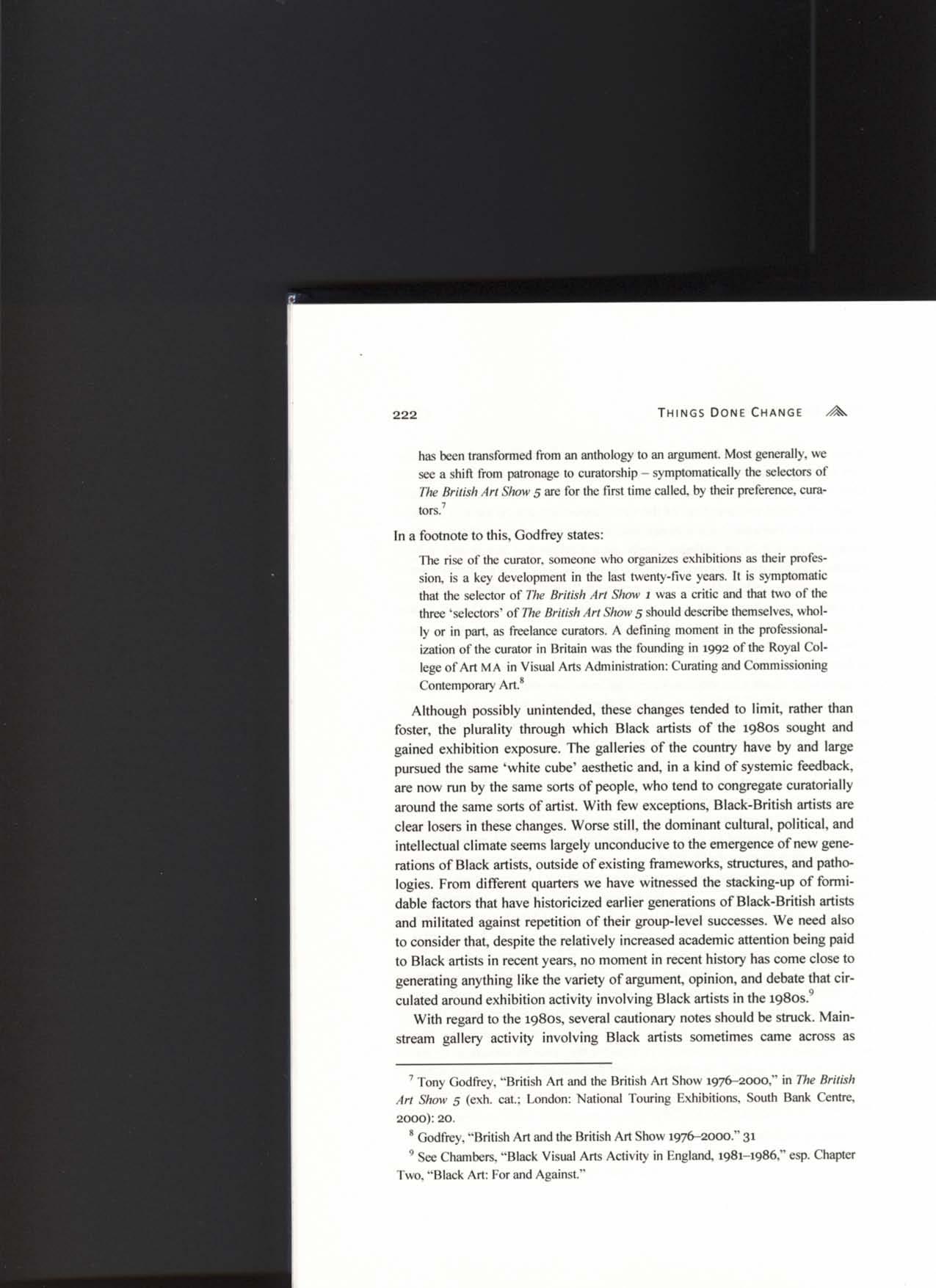
has beentransformed from ananthology to anargument Most generally, we sec a shift from patronage to curatorship - symptomatically the selectors of Hie British ,4n Sliow 5 are for the first lime called, by their preference,curators.'
In a footnote to this,Godfrey states:
The rise of the curator, someone who organizes exhibitions as their profession, is a key development in the last twenty-five years It is symptomatic that the selector of The British An Sliow 1 was a critic and that two of the three "selectors' of The British An Show 5 should describe themselves,wholly or in part, as freelance curators A defining moment in the professionalization of the curator in Britain was the founding in 1992 ofthc Royal Collegeof Art MA in Visual Arts Administration: Curating and Commissioning Contemporary Art.'
Although possibly unintended, these changes tended to limit, rather than foster, the plurality through which Black artists of the 1980s sought and gained exhibition exposure The galleries of the country have by and large pursued the same 'white cube' aesthetic and, in a kind of systemic feedback, are now njn by the same sorts of people, who tend to congregate curatorially around the same sorts of artist With few exceptions, Black-British artists are clear losers in these changes Worse still, the dominant cultural, political, and intellectual climate seems largely unconducive to the emergence of new generations of Black artists, outside of existing frameworks, structures, and pathologies From different quarters we have witnessed the stacking-up of fomiidable factors that have historicized earlier generations of Biack-Brifish artists and militated against repetifion of their group-level successes We need also to consider that, despite the relatively increased academic attention being paid to Black artists in recent years, no moment In recent history has come close to generating anything like the variety of argument, opinion, and debate that circulated around exhibition acfivity involving Black artists in the 1980s
With regard to the 1980s, several cautionary notes should be struck. Mainstream gallery activity involving Black artists somefimes came across as
' Tony Godfrey, "British Art and the British Art Show 1976-2000," in The British .4n Show 5 (exh cat.; London: National Touring Exhibitions, South Bank Centre, 2000): 20
' Godfrey,"British Art andthe British Art Show 1976-2000." 31
' SeeChambers "Blaek Visual Arts Activity in England, 1981-1986," esp Chapter fwo, "Blaek Art: Forand Against."
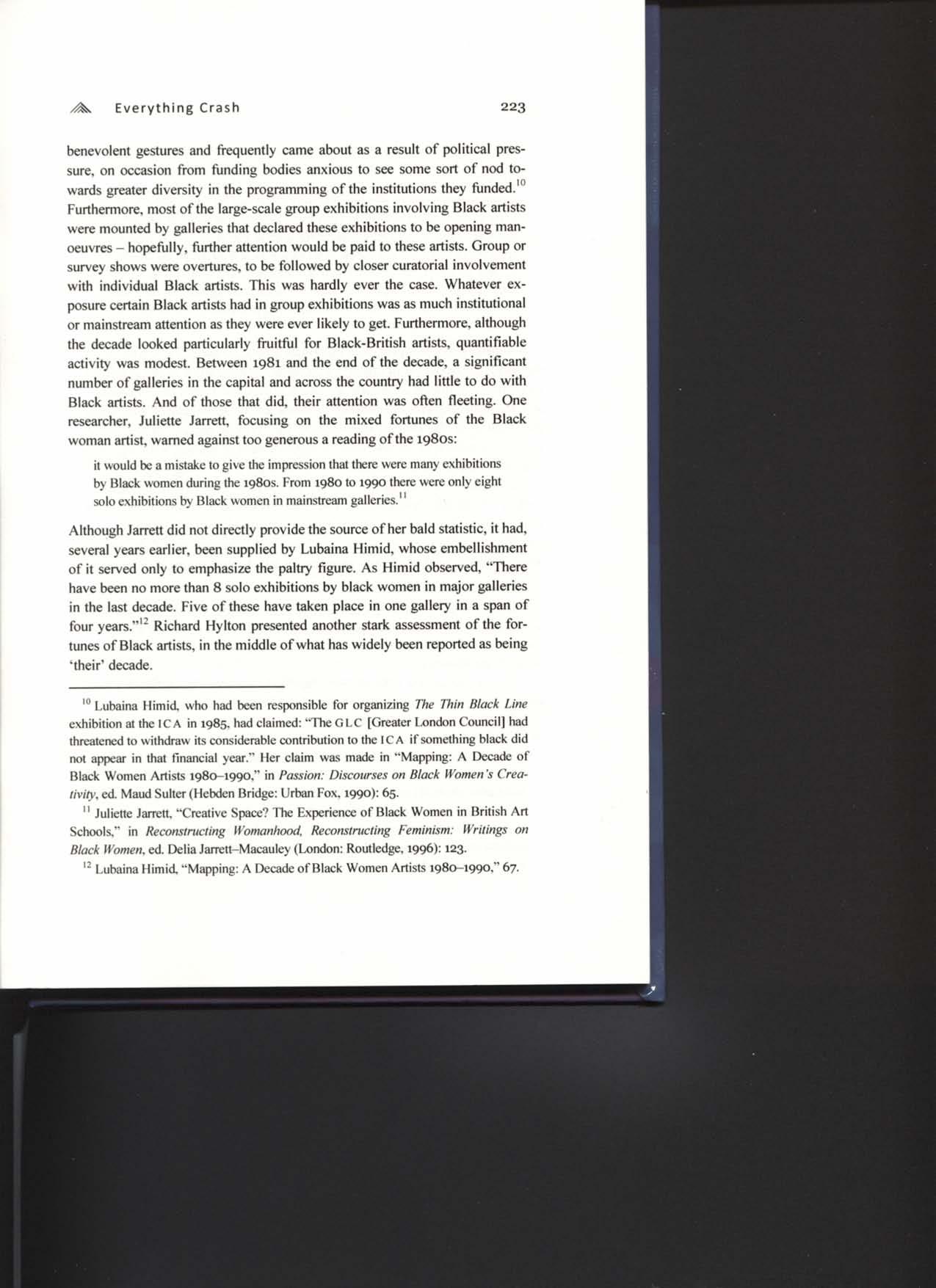
benevolent gestures and frequently came about as a result of political pressure, on occasion from fijnding bodies anxious to see some sort of nod towards greater diversity in the programming of the institutions they funded Furthermore, most of the large-scale group exhibitions involving Black artists were mounted by galleries that declared these exhibitions to be opening manoeuvres - hopefijlly, further attention would be paid to these artists Group or survey shows were overtures, to be followed by closer curatorial involvement with individual Black artists. This was hardly ever the case. Whatever exposure certain Black artists had in group exhibitions was as much institutional or mainstream attention as they were ever likely to get Furthermore, although the decade looked particularly fiuitful for Black-British artists, quantifiable activity was modest Between 1981 and the end of the decade, a significant number of galleries in the capital and across the country had little to do with Black artists. And of those that did, their attenfion was often fleeting. One researcher, Juliette Jarrett, focusing on the mixed fortunes of the Black woman artist, warned against too generous a reading of the 1980s: it would beamistake 10 give the impressionthai there were many exhibitions by Black women during the 1980s From 1980 to 1990 there wereonly eight soloexhibitions by Black women in mainshreamgalleries
Although Jarrett did not directly provide the source of her bald stafistic, it had, several years earlier, been supplied by Lubaina Himid, whose embellishment of it served only to emphasize the paltry figure. As Himid observed, "There have been no more than 8 solo exhibitions by black women in major galleries in the last decade Five of these have taken place in one gallery in a span of four years."'' Richard Hylton presented another stark assessment of the fortunes of Black artists, in the middle of what has widely been reported as being 'their' decade
" Lubaina Himid who had been responsible for organizing The Thin Black Line exhibition at the ICA in 1985. had claimed:"The GLC [Greater Ixmdon Couneil] had threatened to withdraw its considerable contribution tothe ICA if something black did not appear in that financial year." Her claim was made in "Mapping: A Decade of Blaek Women Artists 1980-1990." in Passion: Discourses on Black Women's Creativity, ed MaudSuiter (Hebdcn Bridge: Urban Fox. 1990):65.
" Juliette Jarrett "Creative Space? The Experience of Black Women in British Art Schools." in Recon.slrucling Womanhood, Reconstructing Feminism: Writings on Black Women, ed.Delia Jartctt Macauley (London: Routiedge. 1996):123.
'**Lubaina Himid "Mapping: A Decadeof Blaek WomenArtists 1980-1990."67

During [Arts Council[ Committee meetings, members and representatives were [...] freeto expressmoregeneralconcernsabout the profile andsupport Black artists were receiving from both the Arts Couneil and the gallery sector Comments such as"only one work of art had been purchased by the [Arts Council] Art Department from the many exhibitions by Black artists this year" seem to suggest a general recognition that Blaek artists were receivingaderisors shareof the pie Ihis view was at leastwithin the confines of these meetings, not held solely by advisors of Ethnic Minority Arts Ofticers: "Elizabeth MeCiregor fsie] of the Art department agreed Ihat the Black Art profile in and around the London areas was particularly low despite this beingtheareaof highest aetivitx.""
The perception, however, was that Black artists did particularly well out of the 1980s This view is of crucial importance - having stuck in the mind asa monumentally important decade for Black artists, the 1980s has since stood as a towering and enduring edifice of Black artistic achievement. Much like the framing of the Harlem Renaissance, the 'critical decade' of the 1980s shines as a beacon of achievement, in constant need of fuelling with acknowledgement, appraisal, even adulation.''* Two of the most recent manifestafions of this were offered up in the summer of 2011 by Tate Britain and Graves Gallery, Sheffield, respectively. The Tate presented a display titled Thin Black Line(s). Devised by Lubaina Himid, it reprised, through archival material and a selection of art works, her curatorial interventions of the 1980s, which centred on the multiple practices of Black women artists.'* Running
" Minutes of the Monitoring Committee (Ethnic Minority Arts Action Plan) Held on Wednesday 8 October 1986 point 2 ACOB/32/22, box 10(3 Arts Council of Great Britain archive Victoria and Albert Museum Quoted in Richard Hylton 77ie Nature of the Beast, 64
'•* Critical Decade was a Tcn.S Photo Paperback. Subtitled "Black British Photography in the 1980s."the issue(2.3) was published inSpring 1992
" Thin Black Line(s) ran from 22 August 2011to 18 March 2012. It was described onthe Tatewebsite as follows:
In theearly 1980s threeexhibitions in London curated by Lubaina Himid - Five Black Women at the Africa Centre (1983) Black Women Time Now at Battersea Arts Centre (1983-4) and The Thin Black Line at the Institute for Contemporarx Arts (1985) - marked the arrival on the British art scene of a radical generation of young Black and Asian women artists JTiey challenged their collective invisibility in the art world and engaged with the social, cultural, political and aesthetic issuesof thetime

largely concurently with Thin Black Line(s) was BLK ART GROUP 19831984. The card announcing the exhibifion described the exhibifion in the following terms:
The Blk Art Group was formed in the early 1980s by a radical group of young black artists including Eddie Chambers. Keith Piper. Donald Rodney, and Marlene Smith At atime when theConservative govcmmcnt wasonthe rise and the Brixton riots were shaking London, the Blk Art (iroup emerged asacreative force in Britain.
This exhibition will feature significant works which xverc acquired for Sheffield during the 1980s, but which have rarely been seen since It will also explore the important role that regional galleries, including Sheftleld's, played in supporting and promoting black British art at a lime when many public art institutions were reluctant to engage xviih the political subject matter
The exhibition opened on 7 September and was programmed to continue "unfil March 2012." In such a mind-set comparatively little attention was paid to Black artistic activity before the 1980s, nor, indeed, to that which came thereafter. The conceivably over-generous framing of the 1980s has, perhaps inadvertently, distracted from the task of seeking ever-greater and
fhis dispiax features a selection of key works by some ot these artists. At their core is a conceptual refraining of the image of black and Asian xvomcn themselves Drawing on multiple artistic languages and media, these works repositionedtheblack female presence from the margins tothecentre of debates about representation and artmaking
Most of the wonks on display have been lent by the Arts Council and from artists" private collections. TTiey and local museums were more proactive at the time thannational museums suchasTate in collecting theseworks. The participants in the three exhibitions were: Brenda Agard) Sutapa Biswas. Sonia Boycc. Chila Burrnan.JeanCampbell.Jennifer Comrie. Margaret Cooper. Elizabeth Eugene, Lubaina Himid, Claudelte Johnson, Mumtaz Karimjcc Cherry Lawrence Leslee Wills Houria Niati, Ingrid Pollard Veronica Rxan Marlene Smith,Maud Suiter andAndrea lelman
This display has beendevised by artist Lubaina Himid MBE, Professor of Contemporar>' Art at the University of Central Lancashire, with curator Paul Goodwin.
From http://wxvxv.tate.org.uk/servlet/CollectionDisplays?vcnucid=1&roomid=7237 (accessed29 August 2011).
perhaps, in some Instances, more credible levels of exposure for the wider body of Black artists in Britain in the 1990s and into the twenty-first century. Black art seems frozen in the 1980s. Particularly problematical in this regard was Shades of Black: Assembling Black Arts in 1980s Britain, the 2005 book, which was, as mentioned elsewhere in this study, based on a conference of the same name, which took place at Duke University in 2001. Both conference and book sought to recall, critique, and revisit the supposed glory days of the 1980s. The publicity for Shades of Black centred on a somewhat overblown claim:
In the 198GS- at the height of Thatcherism and in the wake of civil unrest and rioting in a number of British cities - the Black Arts Movement burst onto the British art scene with breathtaking intensitx',changing the nature and perception of British culture irreversibly.'*
In her review of Shades of Black, Courtney J Martin claimed that, for the book and the art it promoted, "One of its chief successes is situating Black British art in the discourse of modernity, thereby bridging one (neglected) gulf between nineteenth-century British art and British art in the 1990s."" Such fijlsome and fancifiil comments stood in marked, sobering, and telling contrast to the studious indifference shown towards most Black artists, by academia and the gallery system alike There is little to no evidence that sentiments such as Martin's were reflected in any wider academic or curatorial engagement beyond what was narrowly defined by notions of race or ethnicity The idea that Brifish culture has been irreversibly changed amounts to a sense of a mission having been accomplished; no ftirther action was required. The Harlem Renaissance analogy applied to Black artistic activity in the 1980s can be detected in the publicity for a Sonia Boyce exhibition at the Bluecoat Gallery in Liverpool in early 2010: "Sonia Boyce, pioneer in the Black British cultural renaissance of the 1980s, is returning to Livenpool's creafive hub, the Bluccoat, 25 years after first exhibiting there."" A more measured, albeit dispiriting, assessment of the legacy of Black artists of the

'* From the back cover of Shades ofBlack, " Courtney J Martin, "Brixton Calling,"/4/-/Jo«r«o/(Spring 2007):119
" Media release for Sonia Boyce, Like Love (Liverpool: Bluecoat Gallety, 30 Januaiy-28 March 2010)
1980s was offered by Niru Ratnam, for whom Britain's 'Black Art' "advocates" were part of atemporary, surface phenomenon."
With the "Black British cultural renaissance"""* of the 1980s being remembered, or constructed, as a noteworthy high point for Black-British artists, there has been an attendant implication that what happened thereafter (and, in some ways, what happened beforehand) was of no great consequence The hyperbole drowning out a more measured or nuanced art historical assessment of Black artists in 1980s Britain has resulted in, or gone hand-in-hand with, a fatal fly-in-amber historicizing of these artists As Gen Doy wrote, "at the end of the twenfieth century, black visual culture is seen by some cultural crifics and historians as something which took place in the 1980s.""'
In the dominant racial pathologies of the art world, what were often slight or modest contributions by Black artists were blown up into highly significant endeavours of lasting valency. Black artists have tended to find that during the 1980s and thereafter, solitary and sporadic group exhibitions of their work went a very long way. A gallery might have had only the briefest flirtation with Black artists, but as far as appearance and perception were concerned, that flirtation was often over-valorized, by the galleries themselves and by onlookers such as the press, in whatever passing interest it sometimes took in these matters. With so many Black artists' exhibitions being relafively large group shows, substanfial individual exhibitions of an artist's work were a rarity. Lubaina Himid noted, when commenting on the impression of the 1980s as a bountifijl period for Black artists.
The pervading impression is therefore of a great proliferation of exhibifions of black artists [sic] work, huge numbers of artists, but no real expanding of anindividuals [sic) boundaries."
Kobena Mercer's appraisal of Black artists' achievements reflected something of the pathology whereby modest and sporadic undertakings took on the
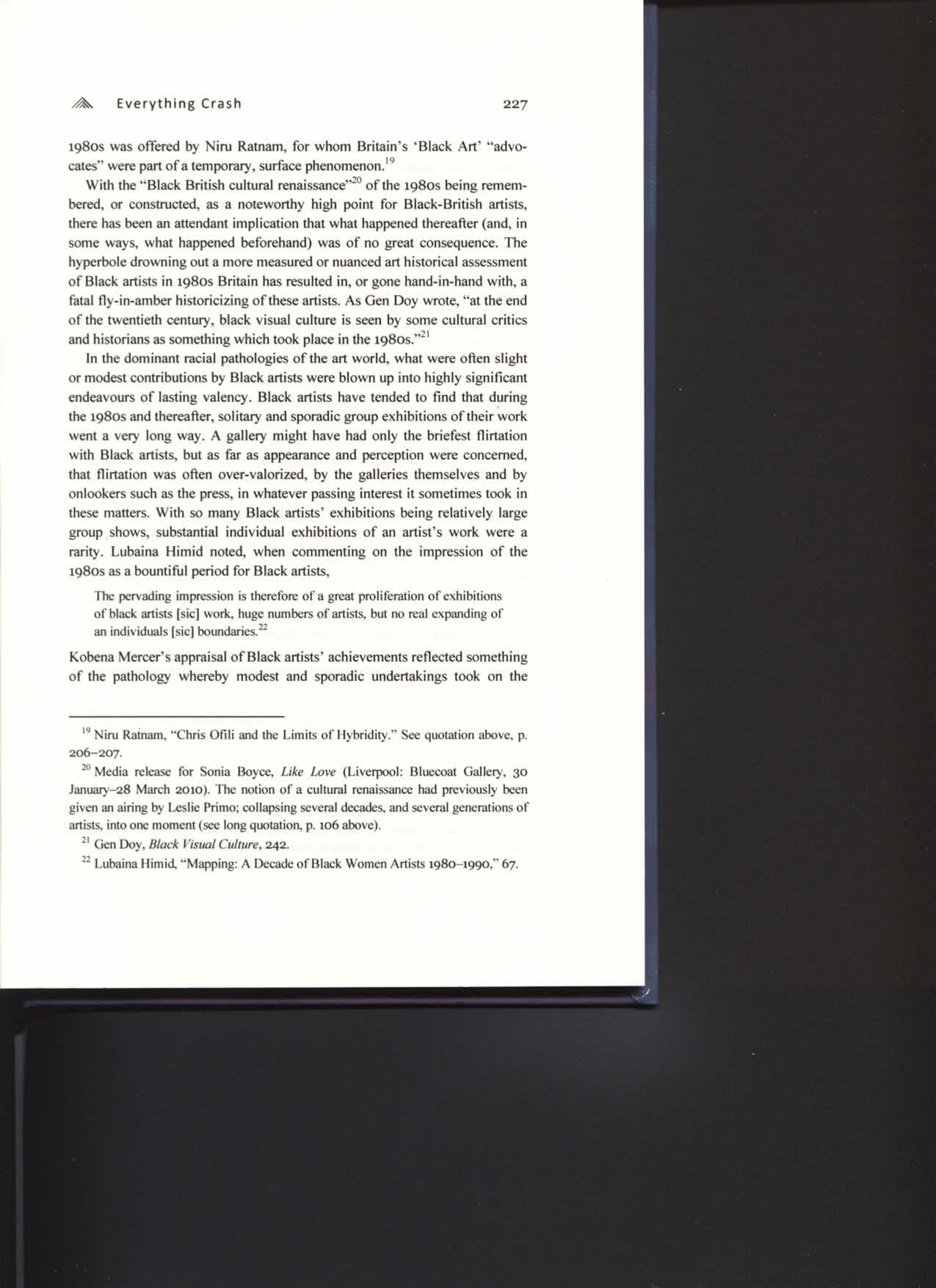
" Niru Ratnam. "Chris Ofiii and the Limits of Hybridity." See quotation above, p. 206-207
~° Media release for Sonia Boyce, Like Love (Liverpool: Bluecoat Gallery 30 January-28 March 2010). Ihe notion of a cultural renaissance had previously been given anairing by Leslie Primo; collapsing several decacfes,and severalgenerations of artists,into one moment (sec long quotation, p. 106above).
" GenDoy, Black Visual Culture, 242.
" Lubaina Himid,"Mapping: A Decadeof Black Women Artists 1980-1990," 67

semblance of something more substantial."'* He cited cities such as Bristol, Liverpool, and Manchester as having "long-standing" track records in showing Black artists' work.""* But precious few venues, in cities such as these, could be said to have had more than a passing or token engagement with Black artists Mercer, though, painted a picttjre of artists who were in a state of satiated bliss and who had effortlessly stamped an indelible mark on the art world:
across the country, black artists from African, Caribbean, South Asian and other backgrounds arc cvcrjxvhere involved in the contcmporarx culture life ofthc nation Cities such as Bristol, Liverpool Manchester, and Bimiingham each have institutions with a long-standing track record in exhibiting black British artists, and indeed, in most any large town in England, Scotland and Wales you would be able to access "culturally diverse" visual arts in one form oranother."
Even allowing for the possibility that "culturally diverse" arts might include artists from overseas and artists from beyond Britain who in recent years might have migrated to the UK, Mercer's upbeat assessment is profoundly at odds xvith the experiences of a great many Black-British artists. In somewhat hyperbolic terms, Mercer claimed that "England's green and pleasant land, one might observe, is noxv inflected by many shades of'black'.""
Mercer, in his comments, conflated Ofili et al. with "black British art" as if they might somehow be one and the same, or interchangeable Ofili had declared himself a supporter of 1N1VA and its Rivington Place building project. Elsewhere, and in a different period of time, Shonibare had declared himself to be a supporter of the Arts Council's efforts in the direcfion of 'cultural diversity', having been a member of the cultural-diversity advisory and monitoring committee ofthc Arts Council and subscquenfly joining the Board of Trustees of INIVA. (Shonibare's work was used to decorate the cover of the
'* Kobena Mercer, •'' Diaspora Didn't Happen in a Day': Reflections on Aesthetics and Time," in "Black" British Aestiietics Toda\\ ed. R. Victoria Arana (Newcastle upon Tync:Cambridge Scholars. 2009): 66-78.
" Mercer, "' Diaspora Didn't Ilappcn ina Day'."66
^* "• Diaspora Didn't Happen Ina Day'." 66
"* •••Diaspora Didn't Happen in a Day'," 67. Within this claim, Mercer had incorporated a reference to Siiades of Black: Assembling Black Arts in 1980s Britain, ed. David A. Bailey. Ian Baiicom & Sonia Boyce (Durham NC; Duke UP & London: 1NIVA/AAVAA,2005).
Cultural Diversity Action Plan for the Arts Council of England, issued in March 1998, although the work in question, a piece called "Deep Blue," 1997, ended up being incon-ectly reproduced at 90 degrees clockwise ) These were, however, for the most part, furtive embraces of developmental or building-base initiatives by these leading artists While, in their art practice, Ofili et al were at various times keen to embrace and make use of the Black image, they were, it seemed, equally keen to distance themselves, and to be distanced, from Black artists as a whole, piecemeal support for cultural diversity and INIVA notwithstanding Ofili, through the imagery and iconography of his projects such as Freedom One Day and Freeness, appropriated potent symbols of Blackness and Black liherafion, but, for the most part, this appropriation was little more than a cross between marketing tactic and advertising strategy."
The undoubted successes of McQueen, Ofili, Shonibare, and a few others, at home and abroad, stood in for the marginalization of a far greater number of Black artists who had not fared nearly so well. Mercer continued:
The global dimension of the process whereby international recognition has been conferred upon "black British artists" has been a crucial aspect of the
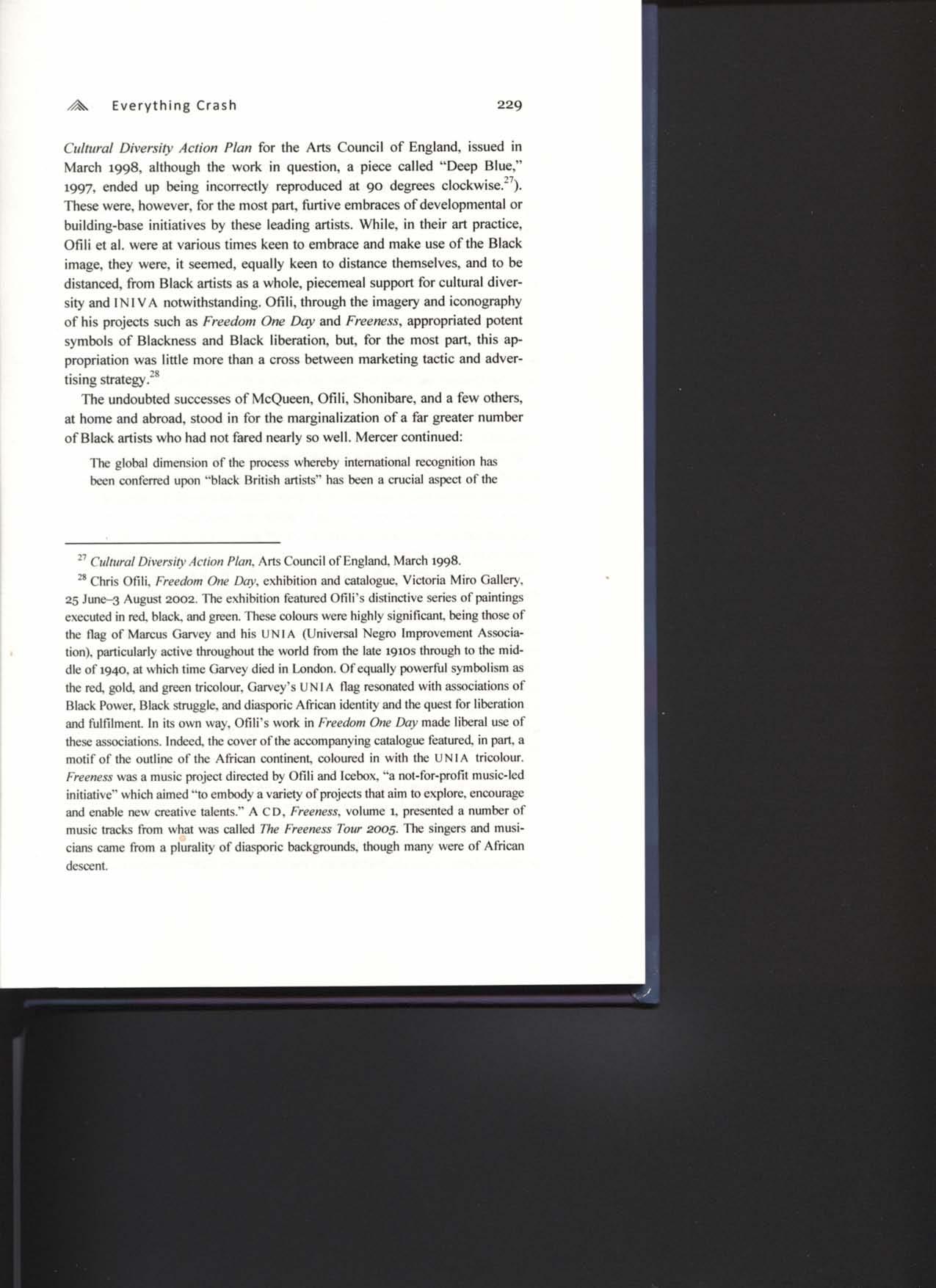
"' Cultural Diversity Action Plan, ArtsCouncil of England March 1998
^' Chris Ofili. Freedom One Day, exhibition and catalogue. Victoria Miro Gallcrx, 25 June-3 August 2002. The exhibition featured Ofili's distinctive series of paintings executed inred.black, and green. These colours were highly significant, being thoseof the fiag of Marcus Garvcy and his UNIA (Universal Negro Improvement Association), particularly active throughout the xvorld from the late 1910s through to the middle of 1940. at which time Garvey died in London. Of equally powerful symbolism as the red, gold, and green tricolour, Garvcy's UNIA flag resonated with associations of Black Power, Black struggle, and dia.sporicAfrican identity and the quest for liberation and fulfilment In its own way, Ofili's work in Freedom One Day made liberal use of these associations. Indeed,the cover of theaccompanying catalogue featured, inpan, a motif of the outline of the African continent coloured in with the UNIA tricolour. Freeness was a music project directed by Ofili and Icebox, "a not-for-profit music-led initiative"which aimed "to embody avariety ofprojects that aim toexplore,encourage and enable new creative talents." A CD, Freeness, volume 1. presented a number of music tracks from what was called The Freeness Tour 2005. The singers and musicians came from a plurality of diasporic backgrounds, though many were of African descent.

evolution of the black arts scene during the 1980s and 1990s, and thetransAtlantic component of this hasbeenespecially important."
Mercer proceeded to cite 1997's New York exhibition Transforming the Crown, But beyond that particular endeavour, and exhibitions such as Interrogating Identity (1991) and Eclectic Flavour (1998), there was little in the way of transatlantic curatorial activity involving Black artists, over and above the blessed few Mercer nevertheless felt able to claim that "'black British art' has now become a recognisable strand in contemporar>' art."'" In appraising the fortunes of Black-British artists, the casual stirring into the mix of Ofili et al. is highly problematical, as their work can more properly be regarded as standing outside of, rather than alongside or as part of, the general pracfice of Black-British artists. Furthermore, the rising fide that bore Shonibare, McQueen, and Ofili to fame most certainly has not had the effect of lifting all boats.
Along with Black artists' ftustrafions at a lack of substantial exhibition opportunities, there existed the concurrent and perhaps not unconnected problem of Black curators and would-be curators being unable to secure meaningful jobs in the visual-arts sector, particularly beyond those projects delineated by Blackness or some such signifier of racial or ethnic difference Continuing his upbeat assessment, Mercer contended "Black arts professionals are among decision-makers in 'British' institutions of art and culture in a way they certainly were not twenty or thirty years ago." "The opportunities," Mercer declared, "are exhilarating," though he qualified this; "fresh anxieties inevitably accompany such an unprecedented moment."" Although Mercer proceeded to raise questions and doubts, the fulsome and unequivocal nature of his assessment may well have been one with which government arts ministers and senior figures from the country's arts funding bodies could concur It was, however, an appraisal that stood in marked contrast to ongoing frustrations on the part of Black artists and Black would-be arts professionals - the former for the most part unable to gain significant access to the country's gallery spaces, the latter unable to secure significant employment opportunities from or within the same institufions.'"
"' Mercer "' Diaspora Didn't Ilappcn inaDay'," 67
^°••• Dia.spora Didn't Happen inaDay'." 67.
31 , " • Diaspora Didn't 1lappen inaDay'," 67
^^ For adiscussion of the poor levels of mainstream gallcrx employment for Blaek people,seeEddie Chambers,"Whitewash," Art Monthly 205 (April 1997):11-12.
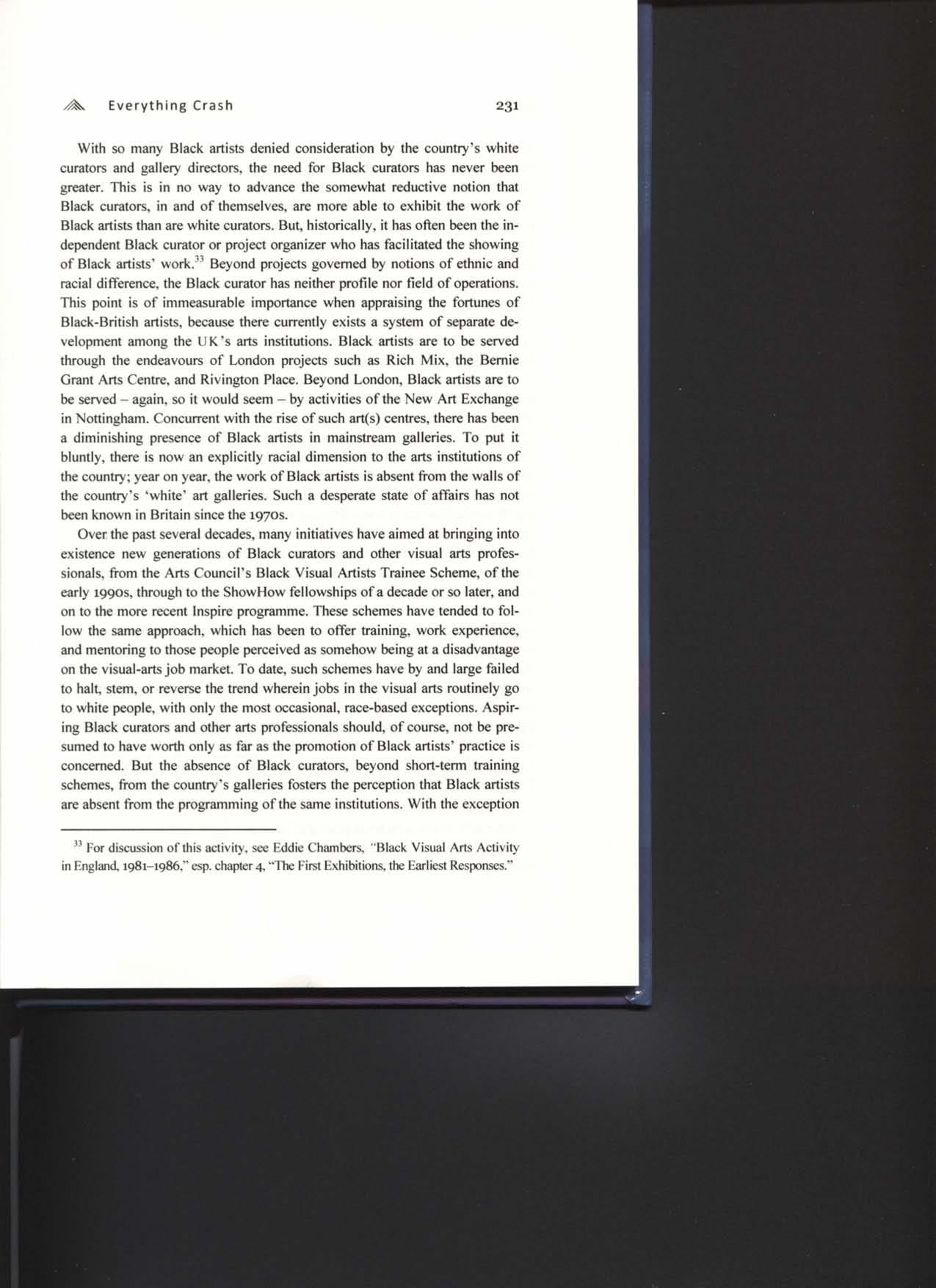
With so many Black artists denied consideration by the country's white curators and gallery directors, the need for Black curators has never been greater This is in no way to advance the somewhat reductive notion that Black curators, in and of themselves, are more able to exhibit the work of Black artists than are white curators But, historically, it has often been the independent Black curator or project organizer who has facilitated the showing of Black artists' work." Beyond projects governed by notions of ethnic and racial difference, the Black curator has neither profile nor field of operations This point is of immeasurable importance when appraising the fortunes of Black-British artists, because there currently exists a system of separate development among the UK's arts institutions. Black artists are to be served through the endeavours of London projects such as Rich Mix, the Bemie Grant Arts Centre, and Rivington Place Beyond London, Black artists are to be served - again, so it would seem - by activifies of the New Art Exchange in Nottingham Concurrent with the rise of such art(s) centres, there has been a diminishing presence of Black artists in mainstream galleries To put it blunfiy, there is now an explicitly racial dimension to the arts institutions of the country; year on year, the work of Black artists is absent from the walls of the country's 'white" art galleries. Such a desperate state of affairs has not been known in Britain since the 1970s
Over the past several decades, many inifiafives have aimed at bringing into existence new generations of Black curators and other visual arts professionals, from the Arts Council's Black Visual Artists Trainee Scheme, of the early 1990s, through to the ShowHow fellowships of a decade or so later, and on to the more recent Inspire programme These schemes have tended to follow the same approach, which has been to offer training, work experience, and mentoring to those people perceived as somehow being at a disadvantage on the visual-arts job market To date, such schemes have by and large failed to halt, stem, or reverse the trend wherein jobs in the visual arts routinely go to white people, with only the most occasional, race-based exceptions Aspiring Black curators and other arts professionals should, of course, not be presumed to have worth only as far as the promotion of Black artists' practice is concerned But the absence of Black curators, beyond short-term training schemes, from the country's galleries fosters the perception that Black artists are absent from the programming of the same institutions With the exception
" For discussion of this activity, sec Eddie Chambers "Black Visual Arts Activity in England 1981-1986."esp chapter 4,••JTieFirst Exhibitions,the Earliest Responses."
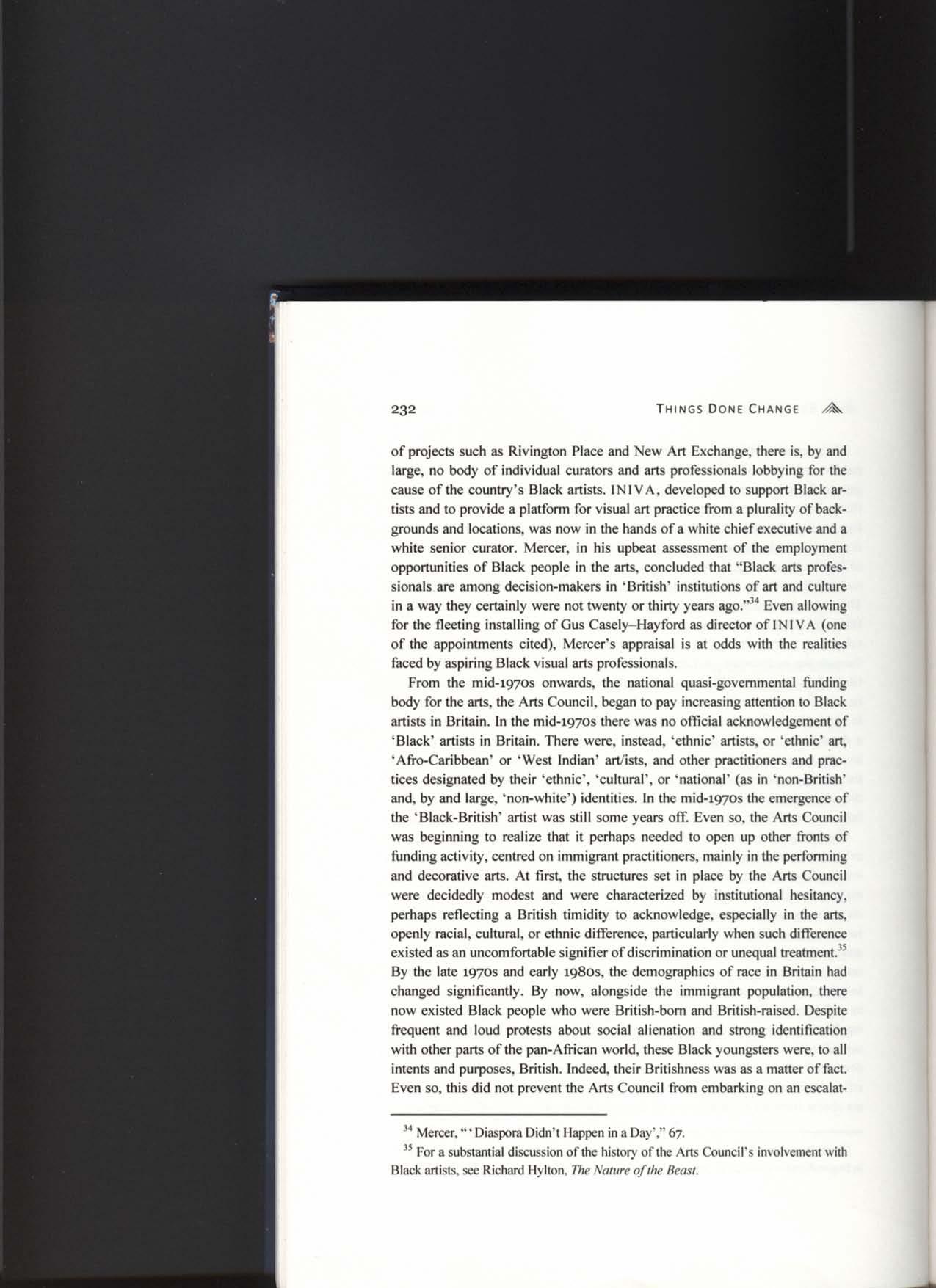
of projects such as Rivington Place and New Art Exchange, there is, by and large, no body of individual curators and arts professionals lobbying for the cause of the country's Black artists. INIVA, developed to support Black artists and to provide a platform for visual art practice from a plurality of backgrounds and locations, was now in the hands of a white chief executive and a white senior curator. Mercer, in his upbeat assessment of the employment opportunifies of Black people in the arts, concluded that "Black arts professionals are among decision-makers in 'British' institufions of art and culture in a way they certainly were not twenty or thirty years ago."* Even allowing for the fleeting installing of Gus Casely-Hayford as director of INIVA (one of the appointments cited), Mercer's appraisal is at odds with the realities faced by aspiring Black visual arts professionals.
From the mid-1970s onwards, the national quasi-govemmental funding body for the arts, the Arts Council, began to pay increasing attention to Black artists in Britain. In the mid-1970s there was no official acknowledgement of 'Black' artists in Britain. There were, instead, 'ethnic' artists, or 'ethnic' art, 'Afro-Caribbean' or 'West Indian' anVists, and other practitioners and pracfices designated by their 'ethnic', 'cultural', or 'national' (as in 'non-British' and, by and large, 'non-white') identities. In the mid-1970s the emergence of the 'Black-British' artist was sfill some years olT. Even so, the Arts Council was beginning to realize that it perhaps needed to open up other fronts of funding activity, centred on immigrant practitioners, mainly in the performing and decorative arts. At first, the structures set in place by the Arts Council were decidedly modest and were characterized by insfitufional hesitancy, perhaps reflecting a British timidity to acknowledge, especially in the arts, openly racial, cultural, or ethnic difference, particularly when such difference existed as an uncomfortable signifier of discriminafion or unequal tteatment.**
By the late 1970s and early 1980s, the demographics of race in Britain had changed significantly. By now, alongside the immigrant population, there now existed Black people who were British-bom and British-raised. Despite frequent and loud protests about social alienation and strong identification with other parts of the pan-African world, these Black youngsters were, to all intents and purposes, British. Indeed, their Britishness was as a matter of fact. Even so, this did not prevent the Arts Council from embarking on an escalat-
** Mercer,"'Diaspora Didn't Happen ina Day',"67.
" For a subslantial discission ofthe historx' of the Arts Council's involvement with Black artists, see Richard Hylton, The Nature ofthe Beast,
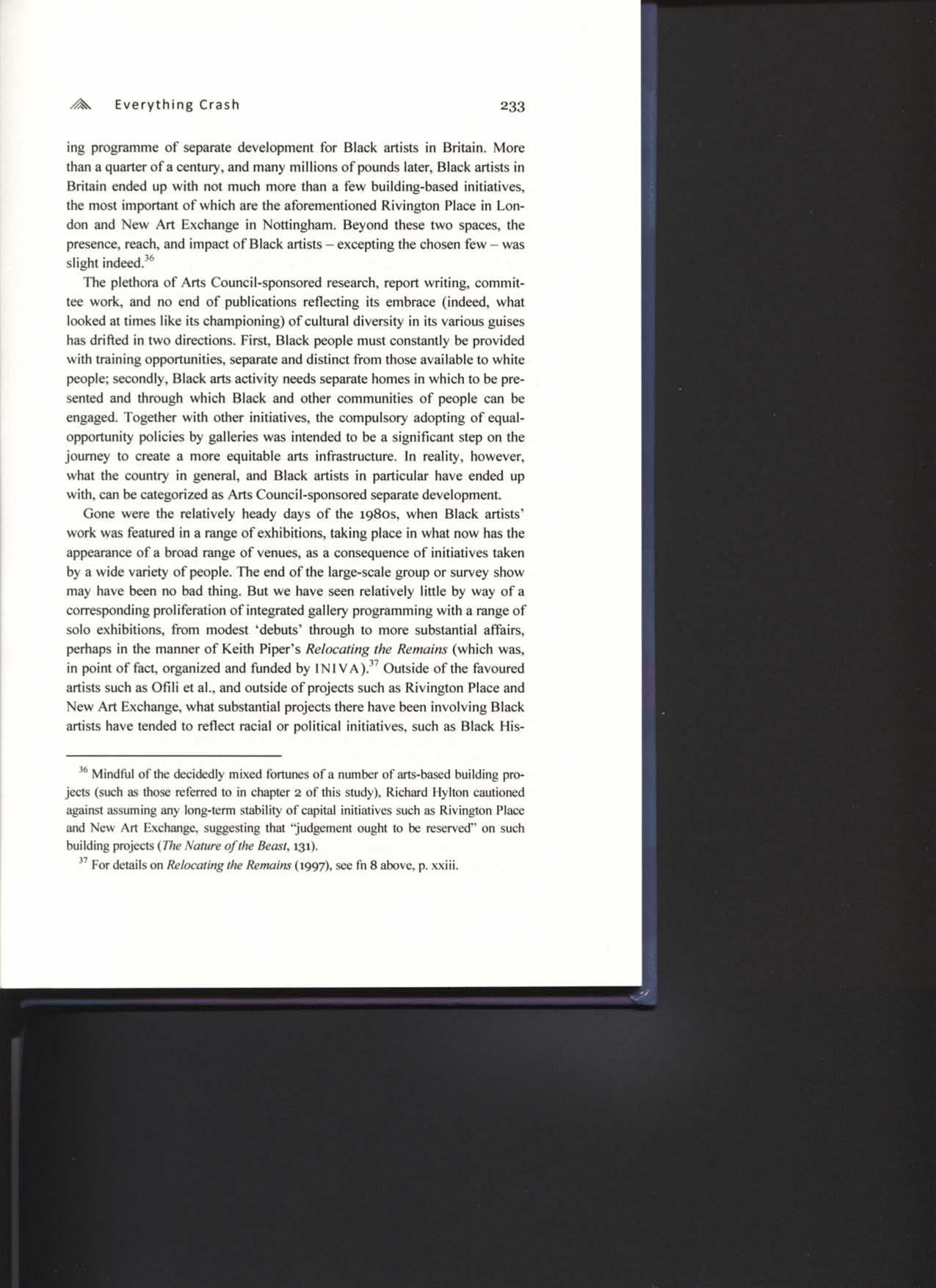
ing programme of separate development for Black artists in Britain, More than a quarter of a century, and many millions of pounds later Black artists in Britain ended up with not much more than a few building-based initiatives, the most Imjxirtant of which are the aforementioned Rivington Place in London and New Art Exchange in Nottingham Beyond these two spaces, the presence, reach, and impact of Black artists - excepting the chosen few - was slight indeed.**
The plethora of Arts Council-sponsored research, report writing, committee work, and no end of publications reflecting its embrace (indeed, what looked at times like its championing) of cultural diversity in its various guises has drifted in two directions First, Black people must constantly be provided with training opportunities, separate and disfinct from those available to white people; secondly Black arts activity needs separate homes in which to be presented and through which Black and other communities of people can be engaged. Together with other inifiatives, the compulsory adopting of equalopportunity policies by galleries was intended to be a significant step on the joumey to create a more equitable arts infrastructure In reality, however, what the country in general, and Black artists in particular have ended up with, can be categorized as Arts Council-sponsored separate development
Gone were the relafively heady days of the 1980s, when Black artists' work was featured in a range of exhibitions, taking place in what now has the appearance of a broad range of venues, as a consequence of initiatives taken by a wide variety of people. The end ofthe large-scale group or survey show may have been no bad thing But we have seen relafively little by way of a corresponding proliferation of integrated gallerx' programming with a range of solo exhibitions, from modest 'debuts' through to more substantial affairs, perhaps in the manner of Keith Piper's Rehxating the Remains (which was, in point of fact, organized and funded by INIVA).** Outside ofthe favoured artists such as Ofili et al., and outside of projects such as Rivington Place and New Art Exchange, what substantial projects there have been involving Black artists have tended to reflect racial or political inifiafives, such as Black His-
*'• Mindful ofthe decidedly mixed fortunes of a number of arts-based building projects (such as those referred to in chapter 2 of this study) Richard Hvllon cautioned against assuming any long-term stability of capital Initiatives such as Rivington Place and New Art Exchange, suggesting that "judgement ought to be reserved" on such building projects(Tlie Nature of tlie Beast, 131)
'* For details on Relocating the Remains (1997),seefn 8 above,p xxiii

tory Month or Abolition 200.*** With rare exceptions, the only 'choice' for Black artists in Britain more recently has been the quarantined initiative, taking place within galleries or contexts that are heavily coded to prevalent social nofions of 'racial", 'cultural", or 'ethnic' 'difference' or 'signification'. Given the Brifishness of so many artists involved in this story, given (he development of anti-discrimination legislation, given all manner of things, we might have expected an altogether different 'trajectory' for Black artists in Britain.
In recent years, several voices were raised against what was perceived as a persistent boxing-in and marginalization of Black-British artists, particularly, though perhaps by default, on the part of funding bodies such as the Arts Council. In March 2007, Richard Hylton's The Nature ofthe Beast appeared, an investigation of cultural diversity and the visual-arts sector over three decades beginning in 1976, the year in which Naseem Khan's report, 77»e Arts Britain Ignores, was published.*'* Hylton set out "to explore the impact that cultural diversity policies and initiatives, within the publicly funded arts sector, have had on Black visual arts activity in England."*" He argued that, though the Arts Council had at times developed what looked like progressive initiatives that empowered Black curators and artists, for the most part it appeared incapable of abandoning or setting aside its construction of Black artists as being 'culturally diverse' and in need of separate development. The Nature of the Beast drew attention to the ever-changing "nomenclature"*' devised to describe Black people and their arts. Although the 'nomenclature' appeared to be ever-changing, what remained consistent, in Hylton's view, was the insfitutional insistence that those perceived as being 'different' needed correspondingly different treatment, attention, and fi/inding structures. The publisher's marketing description stated:
*^It wa.s meniioned in chapter 2 that artists such as Sonia Boyce and Yinka Shonibare undertiKik visual arts projects that were in some instances arguably press-ganged Into an association with Abolition 200, the collective name for events acrossthecountry, which sought to commemorate the 200th anniversaiy ofthe abolition ofthe slave trade by the British Parliament. As mentioned in chapter 4. visual-arts projects suchas Donald Rodney's Display at the Tate were scheduled to coincide with Black History Month
'^Nasccm Khan, The Arts Britain Ignores.
*** From the book's back cover.
*' Richard Hylton, 77ie Nature ofthe Beast, 40.
Richard Hylton ofters thereaderafascinating insight into therolesplayedby the protagonists, including the Greater London Council Arts Council England, publicly funded galleries and arts organizations. Charting cultural diversity's various incarnations, from •ethnic arts" in the late 1970s, "black arts' in the 1980s, "new intemationalism" inthe 1990s and "culturally diverse arts" in the twenty-first centurv', Hylton's study ainsiders how, despite such changes to nomenclature, overly benevolent and prescriptive attempts at inculcating cultural divcrsirv within the visual arts today reprise much ofthe outmoded thinking dating back to the 1970s.
Through in-depth research and analysis, this study a.ssesses the extent to which certain policies and initiatives might have assistedor hindered theprogress of Black artists within the English gallery system. This study meets a long overdue need for a public analysis of cultural diversity policies in the visual arts and will be invaluable toreadersinterested in cultural policy, arts administration,curatorial practiceandthecontemporary visualarts ingeneral.*^
Unlike a subsequent report on the alleged 'boxing-in' of Black artists released several months later Hylton's study elicited no fomi of public response from the Arts Council
Some two months later, Sonya Dyer released her own, somewhat damning assessment ofthe fortunes of Black artists Launched through the Manifesto Club, Boxed In was a report that was trailed and promoted under the blunt claim that government policies ghettoize black artists and brand them as 'second class' The report, written by Dyer, mentioned several sets of financial figures that, if correct, gave an indication ofthe Arts Council's commitment to implementing its cultural-diversity strategies;
In 2002 ACE [Arts Council England] designated £29 million to black, Asian and Chinese-led organisations from its lottery-funded .Arts Capital Programme. ACE has committed 10 percent of its Grant for Arts awards to black andethnic minority artists andartsorganisations 43
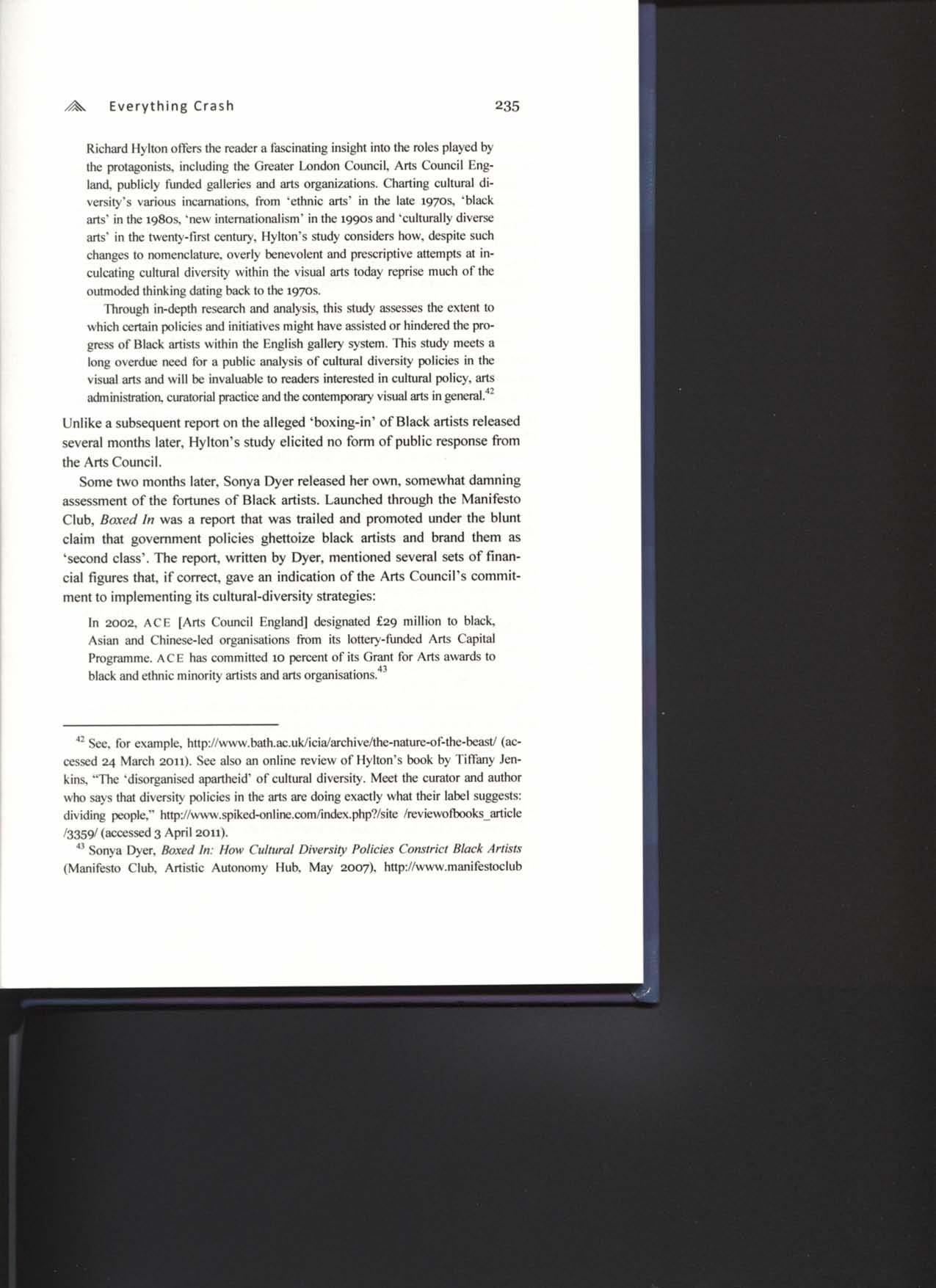
*" Sec. for example, htlp://wvvw.bath.ac.uk/icia/archive/the-naturc-of-thc-beasl/ (accessed 24 March 2011). See also an online review of Hylton's book by Tiffany Jenkins, "The "disorganised apartheid" of cultural diversity Meet the curator and author who says that diverslrv policies in the arts are doing exactly what their label suggests; dividing people," http;//w'ww.splkcd-online.com/index.php?/sitc /reviewofbooksarticle /3359/ (accessed3 April 2011)
** Sonya Dyer, Boxed In: How Cultural Diversity Policies Constrict Black Artists (Manifesto Club, Artistic Autonomy Hub May 2007), http://www.manifestoclub
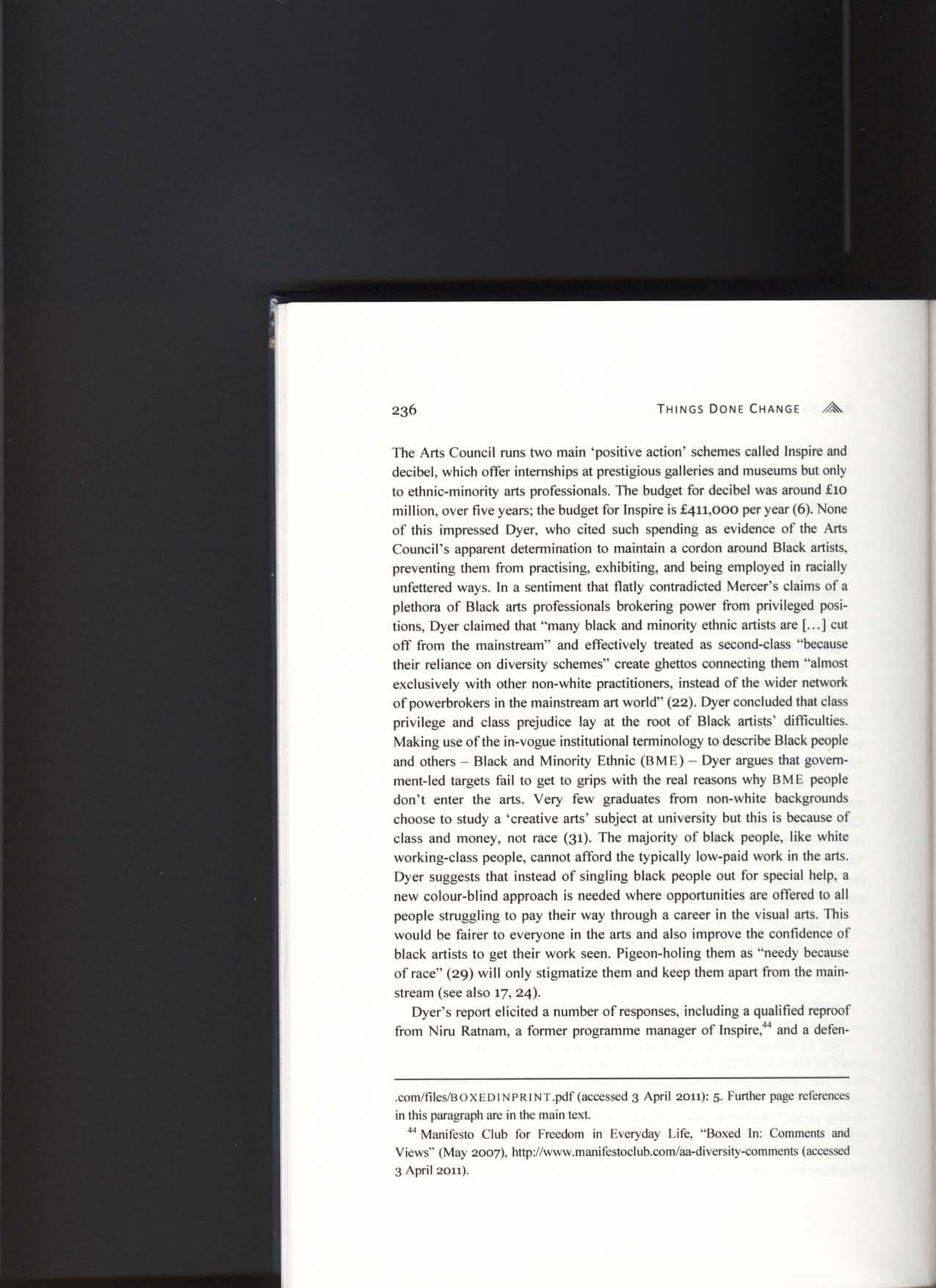
The Arts Council runs two main 'positive action' schemes called Inspire and decibel, which offer internships at prestigious galleries and museums but only to ethnic-minority arts professionals The budget for decibel was around £lO million, over five years; the budget for Inspire is £411,000 per year (6) None of this impressed Dyer, who cited such spending as evidence of the Arts Council's apparent determination to maintain a cordon around Black artists, preventing them from practising, exhibiting, and being employed in racially unfettered ways In a sentiment that flatly contradicted Mercer's claims of a plethora of Black arts professionals brokering power from privileged positions. Dyer claimed that "many black and minority ethnic artists are [...] cut off from the mainstream" and effectively treated as second-class "because their reliance on diversity schemes" create ghettos connecting them "almost exclusively with other non-white practitioners, instead of the wider network of powcrbrokers in the mainstream art world" (22) Dyer concluded that class privilege and class prejudice lay at the root of Black artists' difficulties. Making use ofthe in-vogue institutional terminology to describe Black people and others - Black and Minority Ethnic (BMi:) - Dyer argues that govemment-led targets fail to get to grips with the real reasons why BME people don't enter the arts Very few graduates from non-white backgrounds choose to study a 'creative arts' subject at university but this is because of class and money, not race (31) The majority of black people, like white working-class people, cannot afford the typically low-paid work in the arts Dyer suggests that instead of singling black people out for special help, a new colour-blind approach is needed where opportunities are offered to all people struggling to pay their way through a career in the visual arts. This would be fairer to everyone in the arts and also improve the confidence of black artists to get their work seen Pigeon-holing them as "needy because of race" (29) will only stigmatize them and keep them apart from the mainstream (see also 17, 24)
Dyer's report elicited a number of resjjonses, including a qualified reproof from Niru Ratnam, a former programme manager of Inspire, and a defen.com/fllcs/noxnoiNPRlN I .pdf (accessed3 April 2011): 5 Further page references in this paragrapharc in the main text
** Manifesto Club for Freedom In Everyday Life, "'Boxed In: Comments and Views" (May 2007) http://ww'w.manifestoclub.com/aa-diversity-comments (accessed 3 April 2011)
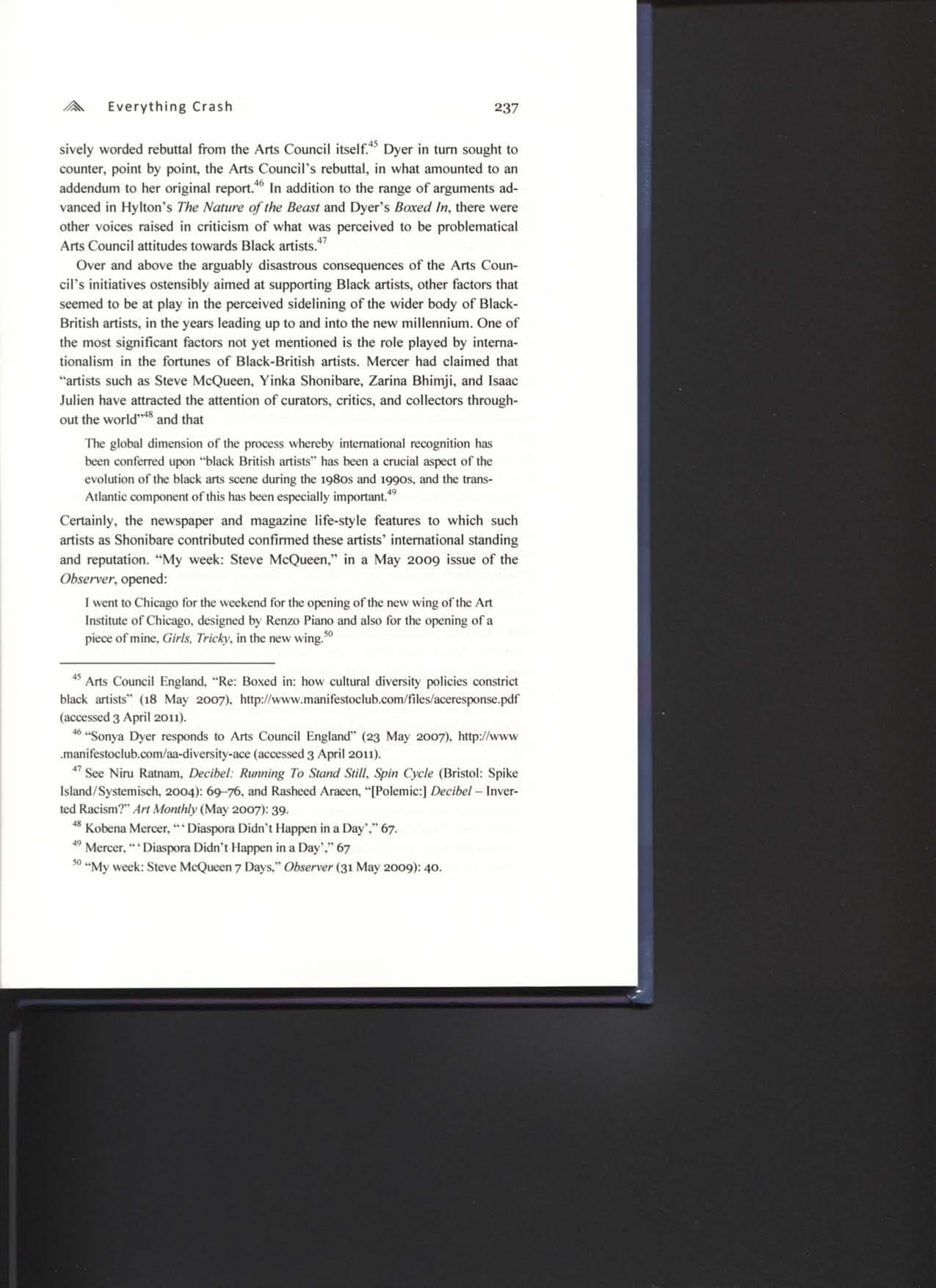
sively worded rebuttal fium the Arts Council itself.** Dyer in turn sought to counter, point by point, the Arts Council's rebuttal, in what amounted to an addendum to her original report.**' In addition to the range of arguments advanced in Hylton's The Nature ofthe Beast and Dyer's Boxed fn, there were other voices raised in criticism of what was perceived to be problematical Arts Council attitudes towards Black artists.**
Over and above the arguably disastrous consequences of the Arts Council's initiatives ostensibly aimed at supporting Black artists, other factors that seemed to be at play in the perceived sidelining of the wider body of BlackBritish artists, in the years leading up to and into the new millennium. One of the most significant factors not yet mentioned is the role played by intemafionalism in the fortunes of Black-British artists Mercer had claimed that "artists such as Steve McQueen, Yinka Shonibare, Zarina Bhimji, and Isaac Julien have attracted the attention of curators, critics, and collectors throughout the world"*' and that
The global dimension of the process whereby international recognition has been conferred upon "'blaek British artists'" has been a crucial aspect of the evolution of the black arts scene during the 198QSand 1990s, and the transAtlanfic aimponent of this has been especially important.* Certainly, the newspaper and magazine life-sryie features to which such artists as Shonibare contributed confirmed these artists" international standing and reputation "My week: Steve McQueen." in a May 2009 issue of the Observer, opened:
1 went to Chicago for the weekend for theopening ofthc new wingofthc Art Institute of Chicago, designed by Renzo Piano and also for the opening of a pieceofmine. Girls, Tricky, inthe newwing.'**
*' Arts Council England, "Re: Boxed in: how cultural diversity policies constrict black artists" (18 May 2007). hHp://www.manifestoclub.com/files/aceresponse.pdf (accessed 3 April 2011)
** "Sonya Dyer responds to Arts Council England" (23 May 2007), hnp;//www .manifcstoclub.com/aa-divcrsity-acc (accessed 3 April 2011).
*•* See Niru Ratnam. Decibel: Running To Stand Still, Spin Cycle (Bristol: Spike Island/Systcmisch. 2004): 69-76. and Rasheed Araeen, ""[Polemic:] Decibel ~ Inverted Racism?" An Monthly (May 2007):39.
*' Kobena Mercer,"""Diaspora Didn't 1 lappen ina Day"," 67
*' Mercer,"'" Diaspora Didn't 1lappcn ina Day"."67
"* "My week: Steve McQueen 7 Days." Observer (31May 2009): 40.
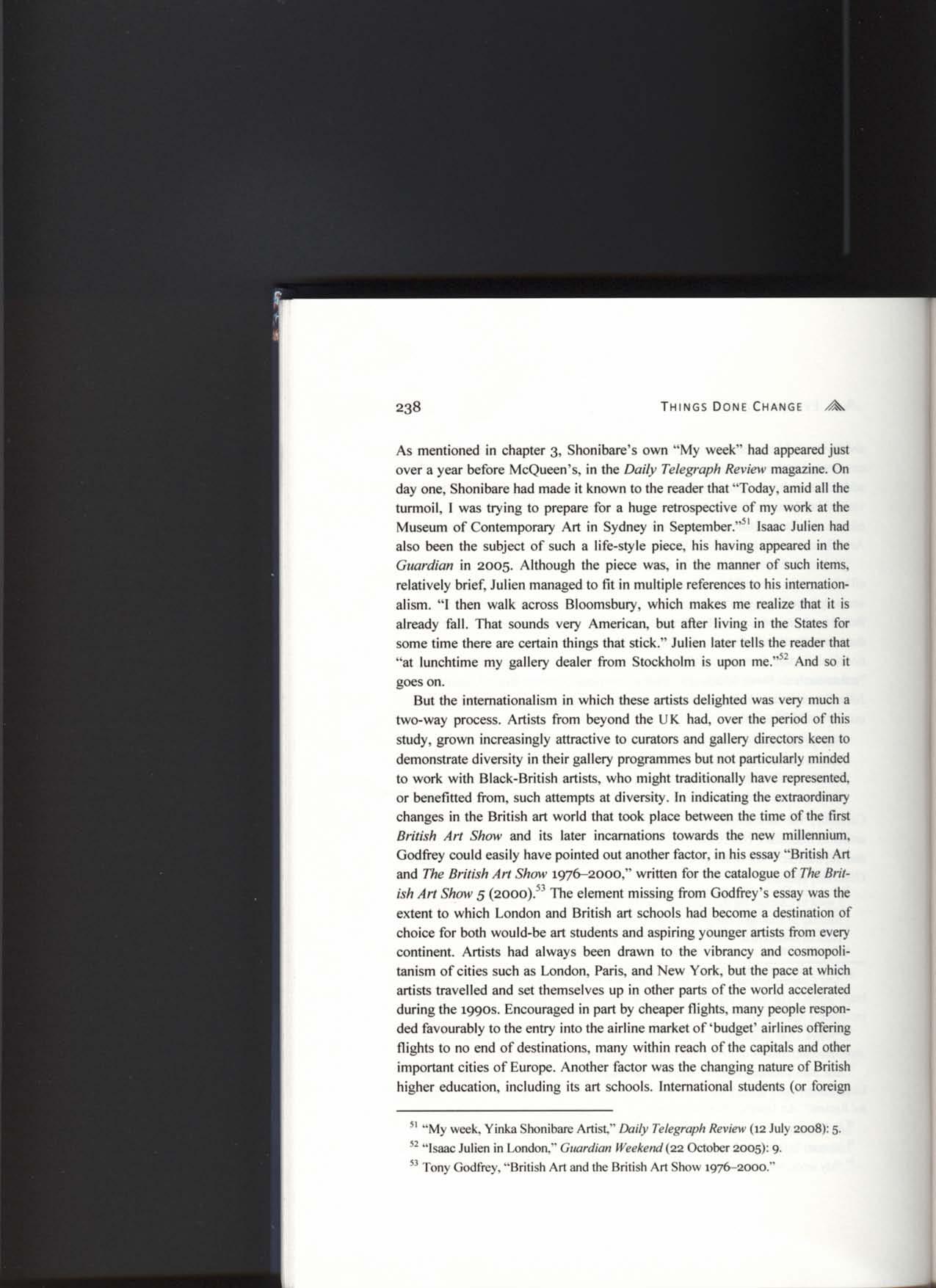
As mentioned in chapter 3, Shonibare's own "My week" had appeared just over a year before McQueen's, in the Daily Telegraph Review magazine On day one, Shonibare had made it known to the reader that "Today, amid all the turmoil, I was trying to prepare for a huge retrospective of my work at the Museum of Contemporary Art in Sydney in September."*' Isaac Julien had also been the subject of such a life-style piece, his having appeared in the Guardian in 2005 Although the piece was, in the manner of such items, relatively brief, Julien managed to fit in multiple references to his intemafionalism "1 then walk across Bioomsbury, which makes me realize that it is already fall That sounds very American, but after living in the States for some time there are certain things that stick." Julien later tells the reader that "at lunchtime my gallery dealer from Stockholm is upon me."** And so it goes on
But the intemationalism in which these artists delighted was very much a two-way process Artists from beyond die UK had, over the period of this study, grown increasingly attractive to curators and gallery directors keen to demonstrate diversity in their gallery programmes but not particularly minded to work with Black-British artists, who might traditionally have represented, or benefitted from, such attempts at diversity In indicating the extraordinary changes in the British art world that took place between the time ofthe first British Art Show and its later incamatlons towards the new millennium, Godfrey could easily have pointed out another factor, in his essay "British Art and The British Art Show J976-2000," written for the catalogue of The British Art Show 5 (2000).** The element missing from Godfrey's essay was the extent to which London and British art schools had become a destination of choice for both would-be art students and aspiring younger artists from every continent. Artists had always been drawn to the vibrancy and cosmopolitanism of cities such as London, Paris, and New York, but the pace at which artists travelled and set theinselves up in other parts ofthe world accelerated during the 1990s. Encouraged in part by cheaper flights, many people responded favourably to the entry into the airline market of'budget' airlines offering flights to no end of destinations, many within reach ofthe capitals and other important cities of Europe. Another factor was the changing nature of British higher education, including its art schools. Intemafional students (or foreign
" "My week Yinka ShonibareArtist" Daily Telegraph Review (12July 2008):5
'^ "Isaac Julien in London," Guardian Weekend (22 October 2005):9
" Tony Godfrey,"British Art andthe British Art Show 1976-2000."

students, as they were then more commonly known) had always been a presence at British universities and polytechnics. But as higher education, under pressure from governmental parsimony, adopted more and more explicit business practices, universities increasingly began to market themselves to prospective, higher-paying students all over the world Consequently, those with the economic means, or whose families were thus endowed, were able to avail themselves of a British (art) college education while bypassing many of the obstacles which had traditionally kept them out ofthe IJK, or prevented them from considering the UK as a destination of choice for their studies. Nicholas Scrota saw fit to comment on this developing intemationalism:
In Britain we live in a society that, broadly speaking, welcomes newcomers Opening doirrs to ea>nomic and political migrants as well asour art schools to students from across the world has beenbeneficial to the visual arts in this country New art flourishes where different streams of consciousness meet Paris in thecarK yearsofthe twentieth century, Berlin in the 1920s andNew York during and immediately after the Second World War provided such meeting points London, it canbeargued, is now suchacentre."*
Furthermore, the language of intemationalism had been proliferating in sections ofthe art world since the beginning ofthe 1990s. Talk of globalizafion, migration, shifting borders, imagined communities, transnationalism etc had indelibly seeped into the discourse of contemporary art, and prettN much everybody - artists, curators, writers, collectors - wanted to avail themselves of some of these new and supposedly exciting ideas.** Particularly important in this regard was the work of the Arts Council-sponsored Institute of New
**Nicholas Scrota ""Foreword." The Turner Prize and British Art (London: Tate 2007): 9.
** By the late 1990s, the discourse of these new altitudes to intemationalism was well established See, for example, Nikos Papastergiadis, The Turbulence of Migration: Giobaiizalion. Deterritorializalion and Hybridity (Oxford: Polity 1999) and Changing Slates: Contemporary Art and Ideas in an Era of Globalisation, ed. Gilanc Tawadros (Ixmdon: INl VA, 2004) Seealso exhibitions such as Imagined Communities, atouring exhibition,organized by Andrew Patrizio National Touring Exhibitions, and Richard 1 lylton, which opened its nationwidc tour at the Oldham Art Gallery, 27 Januaty-24 March 1996 One ofthe earliest exhibitions to encourage Its audiences to consider the interlinked issues of migration, ligation, citizenship, and identity was Shifting Borders, curated by Richard Hylton and featuring photography, mixed media film, and installation works by twelve artists from Europe, Eaing Art Gallery Newcastleupon Tyne,20 Augusl-18 October 1992
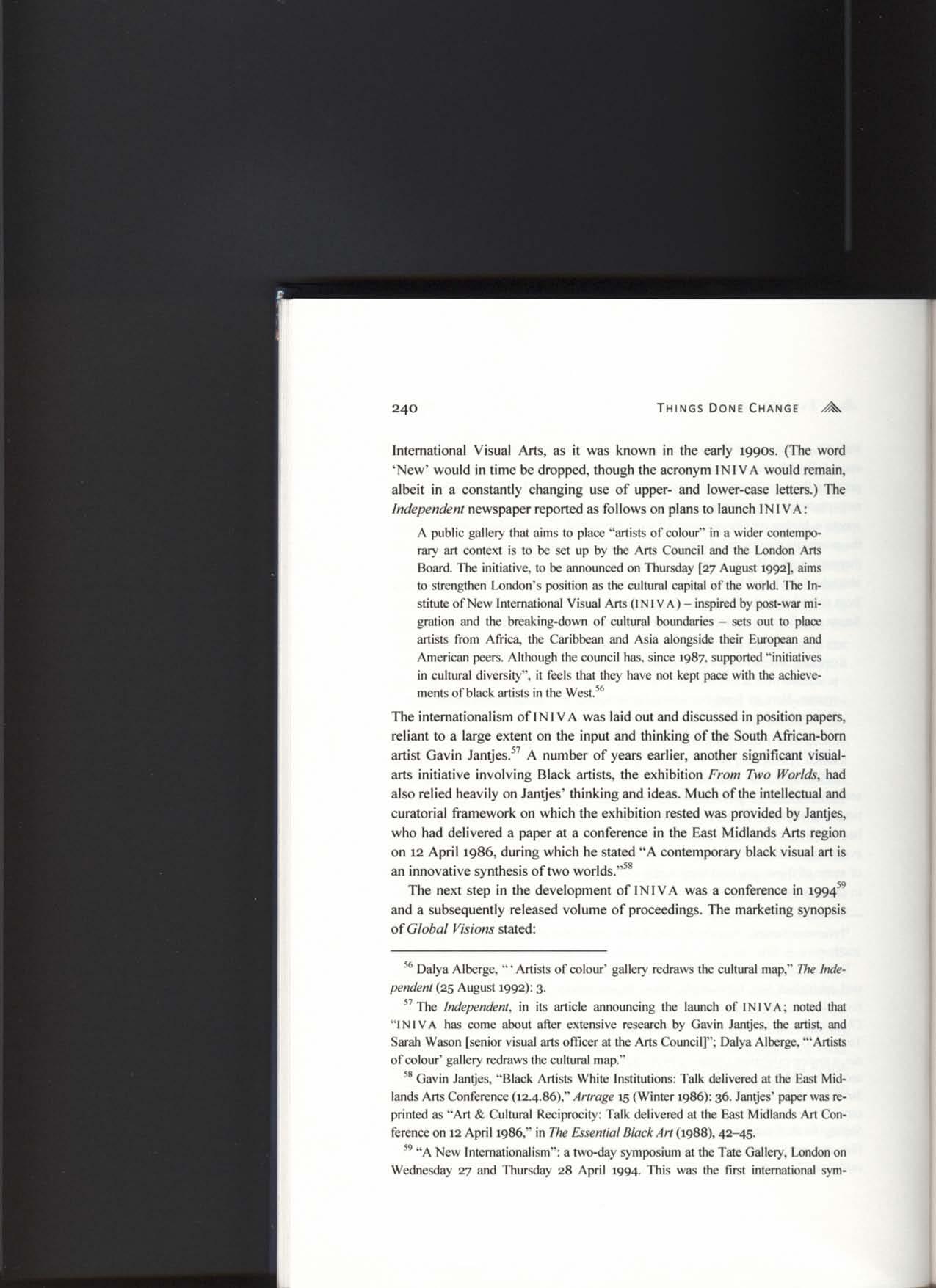
Intemational Visual Arts, as it was known in the early 1990s (The word 'New" would in time be dropped, though the acronym INIVA would remain, albeit in a constantly changing use of upper- and lower-case letters.) The Independent newspaper reported as follows on plans to launch INIVA:
A public gallcrv that aims to place "artists of colour" in a wider contemporary art context is to be set up by the Arts Council and the London Arts Board The initiative, to be announced on I'hursday [27 August 1992J,aims to strengthen London's position as the cultural capital of the world. The Institute ofNew International Visual Arts (INIVA)- inspired by post-war migration and the breaking-down of cultural boundaries - sets out to place artists from Africa, the Caribbean and Asia alongside their European and American peers Although the council has since 1987, supported "initiatives in cultural divcrsirA", it feels that they have not kept pace with theachievementsof black artists in the West.**
The intemationalism of INIVA was laid out and discussed in position papers, reliant to a large extent on the input and thinking ofthe South African-bom artist Gavin Jantjes. A number of years earlier, another significant visualarts initiative involving Black artists, the exhibition From Two Worlds, had also relied heavily on Jantjes" thinking and ideas. Much ofthe intellectual and curatorial framework on which the exhibition rested was provided by Jantjes, who had delivered a paper at a conference in the East Midlands Arts region on 12 April 1986, during which he stated "A contemporary black visual art is an innovative synthesis of two worlds."
The next step in the development of IN1V A was a conference in 1994 and a subsequently released volume of proceedings The marketing synopsis of Global Visions stated:
'* Dalya Alberge, "' Artists of colour" gallery redraws the cultural map," TTie Independent (25 August 1992):3
'* The Independent, in its article announcing the launch of INIVA: noted that "INIVA ha.s come about after extensive research by Gavin Jantjes, the artist, and Sarah Wason [senior visual artsoflicer at the Arts Council]""; Dalya Alberge, '"Artists of colour" gallcr> redraws thecultural map."
" Gavin Jantjes, "Black Artists White Institutions: Talk delivered at the East Midlands Arts Conference (12.4.86)." Artrage 15(Winter 1986):36 Jantjes" paper was reprinted as "Art & Cultural Reciprocity: Talk delivered at the East Midlands Art Conference on 12April 1986." in The Essential Black Art (1988) 42-45
" "A New Intemationalism": atwo-driy symposium at the Tate Gallcrv. London on Wednesday 27 and Ihursday 28 April 1994 This was the first intemational sym-
It is important to reiterate that, in a great many respects, the traffic of internationalism was two-way. Artists came and artists went. As Chris Townsend noted, in a process he referred to as'"reverse migration,"
There are, of course, diverse causes for this cosmopolitan culture. What's happening in the London art scene is in part aconsequence of a larger,continuing transformation of communication and flows of commodities and capital. Britain's membership ofthe European Union (EU) has meant that other EU citizens can live andwork in London,or elsewhere,just as Britons can go to France, or Gcnnany or Spain Even a.s Prime Minister Blair proclaimed theemergence of "CIKJI Brilannia" in ihe late 1990s, harnessing pop culture to the promotion of one political vision of national identity, some of our foremost artists were heading ofl' to live and work elsewhere: lacita Dean to Berlin: Hannah Collins to Barcelona; Steve McQueen to Amsterdam; Lucy Orta to Paris.*'
McQueen to Amsterdain (and for that matter, Tariq Alvi to the Netherlands, Zarina Bhimji to Berlin, and Chris Ofili to Trinidad**) notwithstanding, Black-British artists can in important respects be thought of as net losers rather than net beneficiaries of London's new intemationalism. As I pointed out several years ago,** the process by which Black artists were sidelined in deference to intemational exhibitors had been in place since the late-igSos. At that time, intemational exhibitions were relatively lumbering affairs, focusing on a particular country or otherwise geographically specific art forms. There had for decades been occasional exhibitions from countries of Europe, or from Australia, or the USA, but such exhibitions tended to be 'white' affairs that by and large showed no interest in reflecting matters of racial difference in the countries being curatorially looked at. By the late 1980s, however, such exhibitions, invariably dominated by white males, had begun to fall out of favour, asartists from Africa, South Asia, China, and such parts ofthe world became, albeit fleetingly, more attractive Exhibitions such as Art From South Africa relied heavily on anthropological/curatorial frameworks whereby a particular country was trawled, in an effort to supposedly identify and present the 'best' and most representative bodies of work by
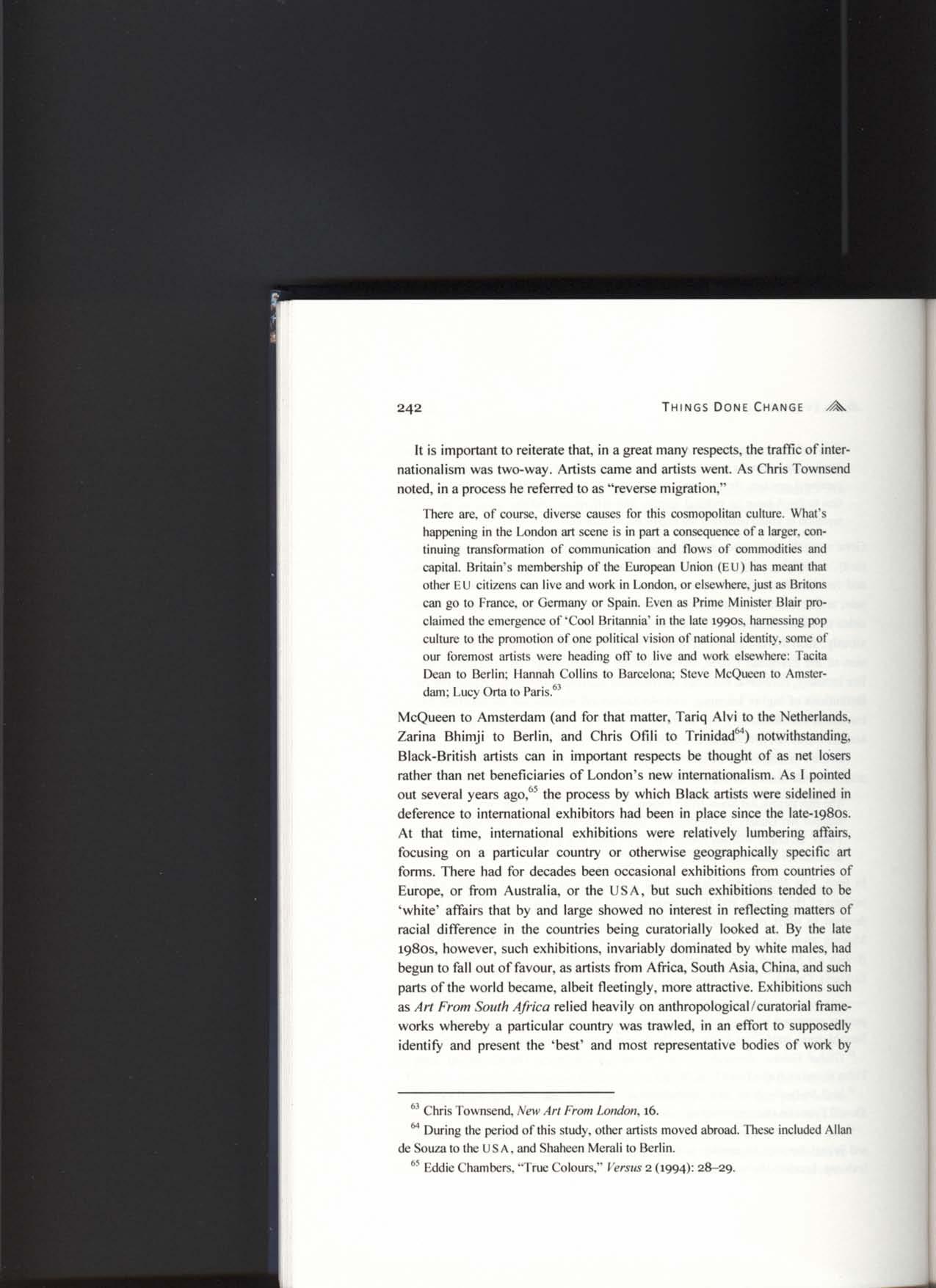
" Chris Townsend, New Art From London, 16.
** During the periodof this study,other artists moved abroad These included Allan deSouzatothe USA, and Shahccn Mcrali to Bcriin.
(,3 Eddie Chambers,""TrueColours," Versus 2 (1994): 28-29.
artists from the country in question In time, such exhibitions, drawn from areas such as India and Aboriginal Australia, were presented in galleries in London and elsewhere in the country.* These were decidedly 'exotic" showings, which allowed domestic gallery-going audiences the opportunity to see bodies of work they might not otherwise be able to access Such exhibitions, however, were to some extent stymied by the notion that supposedly disinterested white curators claimed the privilege of selecting and introducing to British audiences the art of whole nations in other parts ofthe world (No less problematical was the globetrotting star curator, perpetually in and out of airport departure lounges in this country or that, who emerged during the 1990s, having taken over from those curators who only occasionally went abroad in pursuit of curatorial product.) The pathology of these now oldfashioned intemational exhibitions was heavily reliant on Britain's stubbom perception of itself as a monocultural society with a largely monocultural body of British artists on which to draw In this sense, international exhibitions were perceived as pluralizing and diversifying a gallery programme without having to work in any significant way with Black-British artists, whom certain galleries were loth to recognize as convincing practitioners Indeed, the galleries that were most enthusiastic in programming the intemational exhibition were oftentimes those from which Black-British artists found themselves most consistently excluded.*'
Jean Fisher offered a candid assessment ofthe failings of these exhibitions, and proposed a bold explanation for their proliferation:
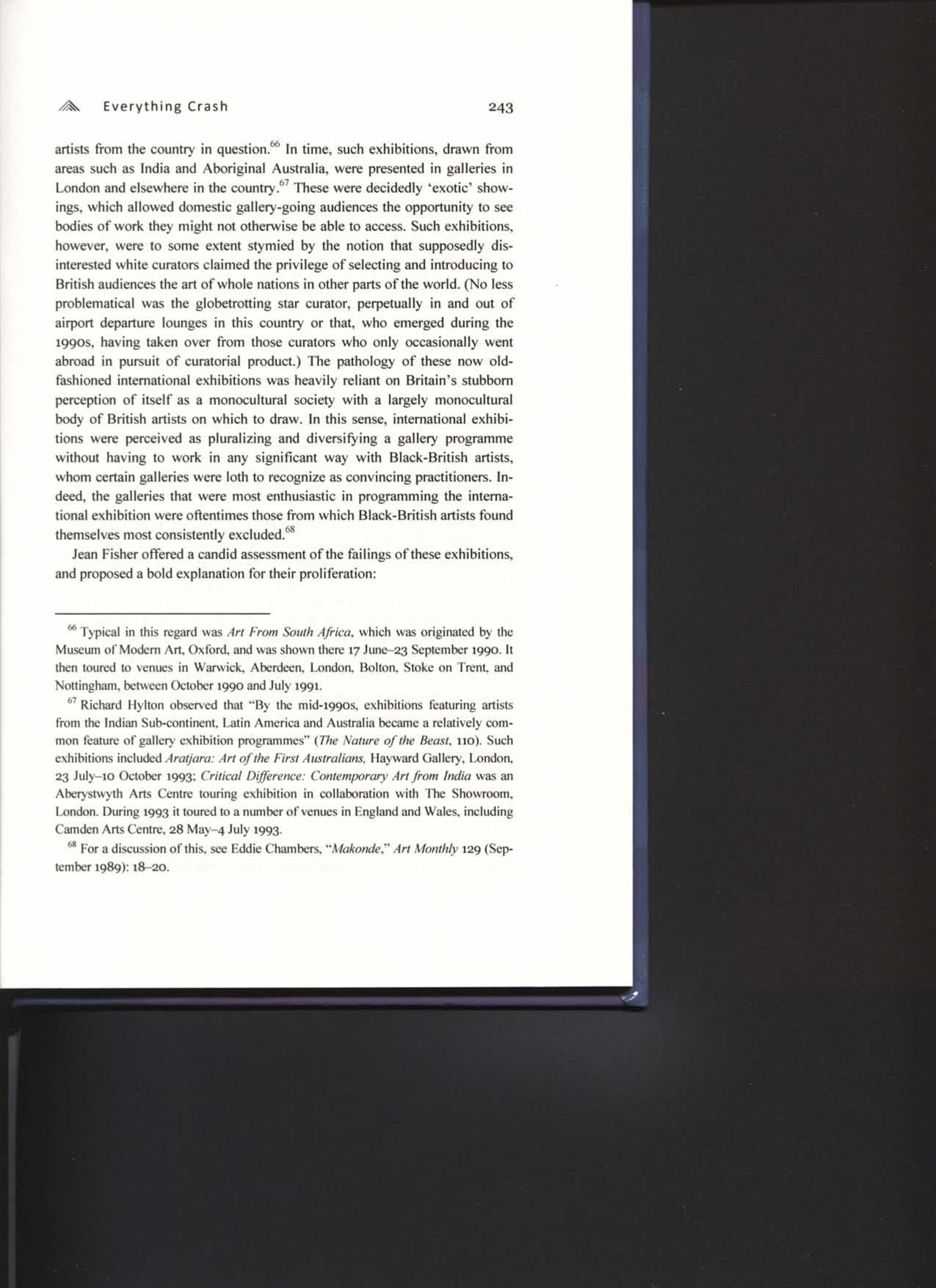
Typical in this regard was ,4rt From South Africa, which was originated by the Museum of Modem Art, Oxford, and was shown there 17 June-23 September 1990. It then loured to venues in Warwick, Aberdeen London Bolton, Stoke on Trent, and Nottingham,bettvecnOctober 1990 andJul\ 1991
** Richard Hylton observed that "By the mid-1990s, exhibitiores featuring artists from the Indian Sub-continent. Latin America and Australia became arelatively common feature of gallery exhibition programmes" (The Nature of tlie Beast. 110). Such exhibitions included Aratjara: Art ofthe First Australians, Hayward Gallery London, 23 July-10 October 1993: Critical Difference: Contemporary Art from India was an Aberysrwyth Arts Centre touring exhibition in collaboration with The Showroom, Ixmdon, During 1993 it touredto anumber of venues in EnglandandWales, including CamdenArts Centre,28 May-4 July 1993
*' For adiscussion of this, see Eddie Chambers, "Makonde," Art Monthly 129(September 1989); 18-20 r

Exhibitions based on ethnic interpretations of multiculturalism that arise from the current fashion for curatorial globe-trotting have mostly failed to advance an understanding of contemporary visual art from beyond the Western merropolis In Britain, a glance at recent exhibitionreviewstouching on such themes as "New Art from China (or India, Cuba, etc.)," is enough to eonfimi the suspicion that the esthetic concerns oi"individual artists continue to he neglected in favor of redundant assumptions about ethnicity or poorly informed comparisons with Westem Modernism. Why ihis continues tooccur may seem puzzling, hut one factor that must be taken into account isthe impulse of some poorer nation.s to '"exoticizc" themselves in order to gain a stronger footing inthe Westem art market. While many exhibitions arcquick tocontextualize non-Westem work wilh anthropological anecdotes, historical context is usually missing from the equation Without it, we cannot helpbut fail lo understand the trajectory of global Modemism as it has evolved outside the West.**
Araeen was similarly critical, offering the following judgment: With the emergence of postmodernism and globalisation, with openings for artists from other cultures to enter its space and become celebrated as partof the global spectacle, the intellectual energy of the Third World was sucked into thesespectacles.'*
As mentioned, by the mid-jggos the nature of intemational exhibitions had been markedly transformed. Singly curated presentations of supposedly representative samples of artistic practice from this or that distant country were out. This, as Godfrey had stated, was when "the large group show [was] transformed from an anthology to an argument."" Intemational exhibitions became multi-stranded projects that drew together artists from a number of different countries, in their attempts to develop arguments about contemporary conditions that were seen as having universal application. Referring to the rise ofthe notion of hybriduty, Niru Ratnam noted that the "shift from" what he called "the didactic work ofthe late J97OS and 1980s to Ofili's more open-ended, lucid approach mirrors a shift in contemporary postcolonial theory." Ratnam went on to mention the articulating, by the likes of Stuart Hall, of "'a new polifics of representation', where the black experience was 94-
70
' Jean Fisher, "Seven stories about modem art in Afiica." Artfomm (January 1996): Richard Dyer,'"RasheedAraeen inConversation." Wasafiri 53(Spring 2008): 30. Tony Godfrey. "British Art and the British Art Show 1976-2000." 20

primarily diasporic and centred on the 'process of unsettling, recombinafion, hybridization and "cut-and-mix"' ."'^
It was at this moment that the art world began to take increased notice of biennales and mega-exhlbitions across the world beyond the established and long-recognized ones, such as Venice and Documenta Particularly important in this regard were the Istanbul Biennial and the Cairo Biennale, both established in the mid-1980s, and the Johannesburg Biennale, which took place twice in the 1990s. In addition to presenting intemational group exhibitions of work by artists from several different countries, the British art world began to stage increased numbers of solo exhibitions by such artists With even the most unassuming and provincial of gallery spaces in Britain seeking to avail themselves of this latter-day intemationalism, all but the most favoured Black artists found their chances of substantial gallery attention shrinking even further, asmore and more galleries sought to intemationalize their curatorial programmes, as a nod towards cosmopolitanism and diversity The coterie of freshly minted intemational curators emerging in the 1990s were interested in few Black-British artists beyond such already familiar names as Bhimji, Julien, Locke, McQueen, Ofili, and Shonibare. This limited horizon extended to similarly limited numbers of familiar names of favoured artists drawn from other countries Thus, in biennales, biennials, and other mega-exhibitions it was possible for international audiences to see the same sorts of work, from the same sorts of artists, time and again In this regard, the artists mentioned above were clear beneficiaries of these shifts in international cultural politics, away from what were regarded as worthy but dull approaches to art and politics: "the world of visual arts has realized that hybridity allows a release from dreary identiry politics work and has embraced Ofili with open arms." *
Richard Hylton summarized something ofthe impact and consequences of intemational dimensions on Black-British artists
Although the •intcmatlonalising' ofthe visual arts programmes across England may have reflected changes occurring within the intemational art world
" Niru Ratnam,"Chris Ofili andthe Limits of Hybridity." 155
" Africus: Jolianneshurg Biennale, 28 Februarv-30 April 1995: 2nd Johannesburg Biennale 1997, Trade Routes: History and Geography, 12 October 1997-18 Januar>' 1998. For a critique of the second Johannesburg Biennale, see Eddie Chambers. "Johannesburg: A Review of the Second Johannesburg Biennale." Art .Monthly 212 (December 1997-Januar> 1998): 14-18
" Niru Ratnam,"Chris Ofili andthe Limits of Hybridity." 157
it also signaled a tendency for major publicly funded galleries in England to privilege artists of colour from abroad above Black British artists In the early to mid-1990s, artists such as Keith Piper, Zarina Bhimji, Permindar Kaur. Veronica Ryan and Shirazeh Houshiary commanded solo shows at major public funded galleries However, such opportunities became increasingly rareaspublicly funded galleries, particularly major independentspaces, began toaccommixiate artistsof colour from abroad. '
Hylton went on to reiterate the sentiment that "there was a certain correlation between galleries' eagemess to display the work of artists from all comers of the world and the increasing obsolescence of Black artists to the English gallery system."'*
A formidable range of obstacles and adverse developments served to frustrate the ambitions of most Black-British artists to thrive as individual practitioners. As mentioned in chapter 4, the Tate's strategy for dealing with Black artists involved seeking to incorporate them posthumously into nanratives of British art. But the Tate was not alone in this regard. Fulsome, adulatory exhibitions by recently deceased and long-deceased, artists came to be a significant aspect ofthe presence of Black artists in the gallery system. Such exhibitions could not be separated from the general profile of Black artists, simply because such exhibitions represented a Black presence in the country's galleries. By seeming to rescue certain dead Black artists from obscurity and belatedly recognizing others, galleries were thus able to demonstrate not only liberal credentials but also,just as importantly, a commitment to diversity and inclusivity. The rise in exhibitions of dead Black artists helped to reduce still further whatever residual interest in living Black artists that a gallery might have Such exhibitions were sometimes accompanied by catalogues, the size and lavishness of which only a favoured handful of living Black artists could ever hope to enjoy during their lifetime In the dominant racial pathologies of fJie art world, such sporadic exhibitions of dead artists' work went a very long way Rather than being seen as 'historical' exhibitions, a perhaps necessary supplement to exhibitions of work by living artists, they became instead emphatic signifiers of the general presence of living Black artists, thereby further entrenching an already entrenched marginality In that regard, dealing
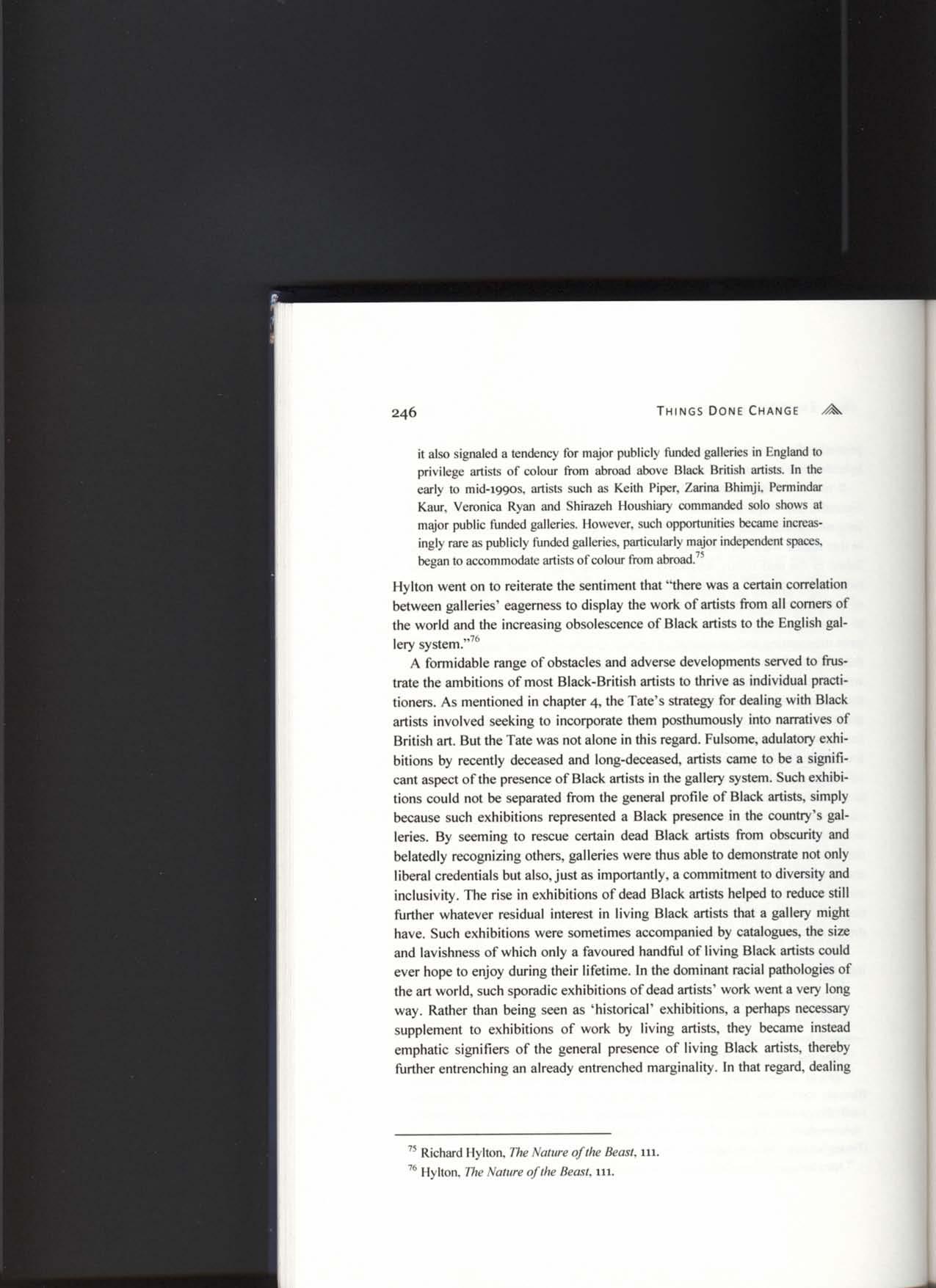
'* Richard Ilylton. The Nature ofthe Beast, ill.
'* Hylton. The Nature ofthe Beast, in.

with dead Black artists became another way for the art establishment to avoid having to deal with Black artists who lived and breathed
For several years, from the mid-1980s onwards, the Horizon Gallery distinguished itself as a substanfial exhibition space, located in central London, in which visitors could expect to see work by practitioners of primarily South Asian background. The gallery was run by, and home to, a body known as the Indian Arts Council It hosted a number of important exhibitions, including Sutapa Bisivas: Recent Paintings (17 June-u July 1987). When the gallery closed in 1991,a well-located venue dedicated to showing the work of artists with, frankly, limited exhibition options was lost Within a couple of years of the Horizon Gallery's closing, the Black-Art Gallery, in Finsbury Park, also closed its doors for the final time, having had its core funding withdrawn by Islington Borough Council While neither of these galleries was without its critics, for periods of about five and ten years respectively they provided exhibition opportunities for significant numbers of artists, albeit practitioners representing different, demarcated constituencies Notwithstanding the establishment of Rivington Place, the gallery-based home to INIVA and Autograph (Association of Black Photographers), the closure of the Horizon Gallery and the Black-Art Gallery effectively meant that two particular venues were lost and not replaced.
Other not insignificant venues to be lost included the Africa Centre and the Commonwealth Institute, again well-located central-London sites The Africa Centre, in Covent Garden, hosted several ofthe most important exhibitions that signalled the emergence of a new generation of Black artists. These included The Pan-Afrikan Connection'^ and Five Black Women Artists:'' During the 1980s, the Commonwealth Institute's two exhibition spaces - the main gallery, and a smaller area known as the Bhownagree Gallery - had hosted a significant number of shows by Black-British prac-
" Several of INIV A's most substantial exhibitions to date Involved presenting exhibitions of work by dead artists, suchasAubrey Williams at the Whiiechapel Art Gallery (12June-16 August 1998) and l.i Yuan-chia al Camden Arts Centre (26 January18 March 2001, before touring to other venues) For a critique of this, see Eddie Chambers,""DeadArtists' Societ>',"" Art Monthly 244 (March 2001):15.
'* Eddie Chambers, FJominic Dawes, Claudette Johnson, Wenda Leslie, and Keith Piper;4 May-4 June 1982
" Sonia Boyce, Lubaina Himid, Claudette Johnson, Houria Niati, and Veronica Ryan;6 September-14October 1983
titioners, as well as artists from other parts ofthe Commonwealth Aubrey Williams had exhibited there, as had younger painters such as Denzil Forrester (who exhibited drawings in the Bhownagree Gallery, 4-28 April 1986). With the closing of the Commonwealth Institute, opportunities for Black artists to exhibit were further reduced
Chapter 1above mentioned the sorts of exhibitions, such as Woven Air. that had become an irregular but consistent aspect of the Whitechapel Art Gallery programme, as a means by which the communities of South Asian peoples that existed in the vicinity ofthe gallery would supposedly be addressed and catered for. In addition to offerings such as Woven Air and Living Woodf the gallery also served up fare such as Krishna The Divine Lovef(programmed during the year in which celebrations marking the fiftieth anniversary of Indian and Pakistani Independence took place) and, in 1999, ooozerozerozenf' More recently, the gallery hosted Where Three Dreams Cross: 150 Years of Photography from India, Pakistan and Bangladesh. While, for these types of exhibition, the Whitechapel presented itselfassomething of a 'local' gallery, these exhibitions often functioned as signifiers ofthe London art world's capacity to embrace and demonstrate plurality Such was the Whitechapel Art Gallery's resistance to programming substantial exhibitions by individual Black practitioners that, following Sonia Boyce's exhibition (in a gallery space on the upper level ofthe building) in 1988,'* it would
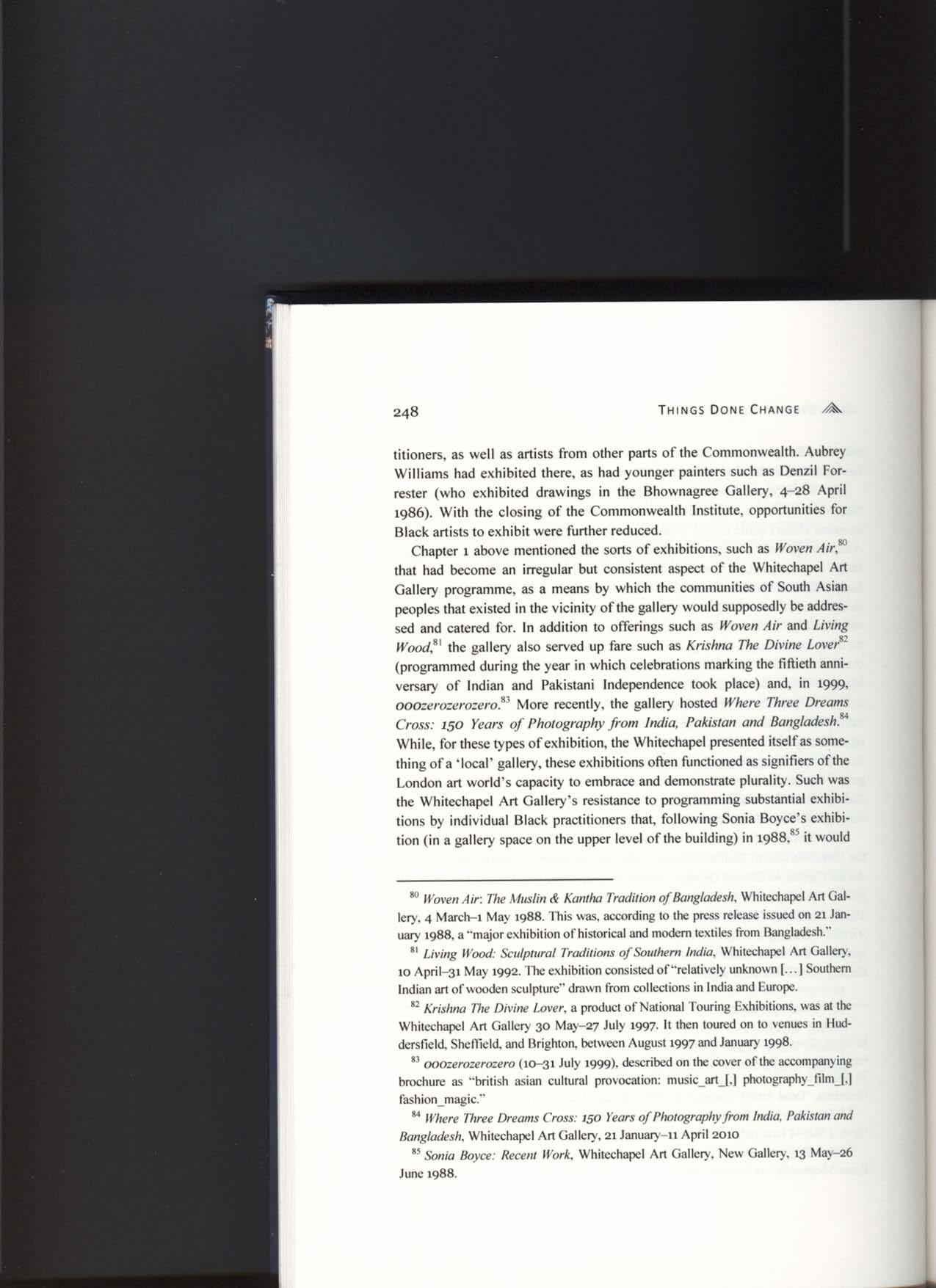
'* Woven Air; The Muslin 6) Kantha Tradition of Bangladesh, Whitechapel Art Gallery 4 Mareh-i May 1988 This was,according to the pressreleaseissuedon 21 January 1988 a"major exhibition of historical andmoderntextiles from Bangladesh."
*' Living Wood: Sciiiplurai Traditions of Southern India, Whitechapel Art Gallery, 10April-31May 1992.Theexhibition consistedof "relatively unknown [...[Southern Indian art of wooden sculpture" drawn from collections in IndiaandEurope.
*' Krishna Tlie Divine Lover, a prrrduct of National Touring Exhibitions, wasatthe Whitechapel Art Gallery 30 May-27 July 1997- It then toured on to venues in Huddersficld Sheffield, and Brighton,betweenAugust 1997and Januarv-1998
*' ooozerozerozero (10-31 July 1999) described on the cover ofthe accompanying brochure as "british asian cultural provocation: music_art_[,l photography_filmJ.] fashionmagic."
** Wiiere Three Dreams Cross: 150 Years of Photographyfrom India. Pakistan and Bangladesli, Whitechapel Art Gallcrv-, 21January-ii April 2010
"* Sonia Boyce: Recent Work, Whitechapel Art Gallery New Gallcrv- 13 May-26 June 1988.
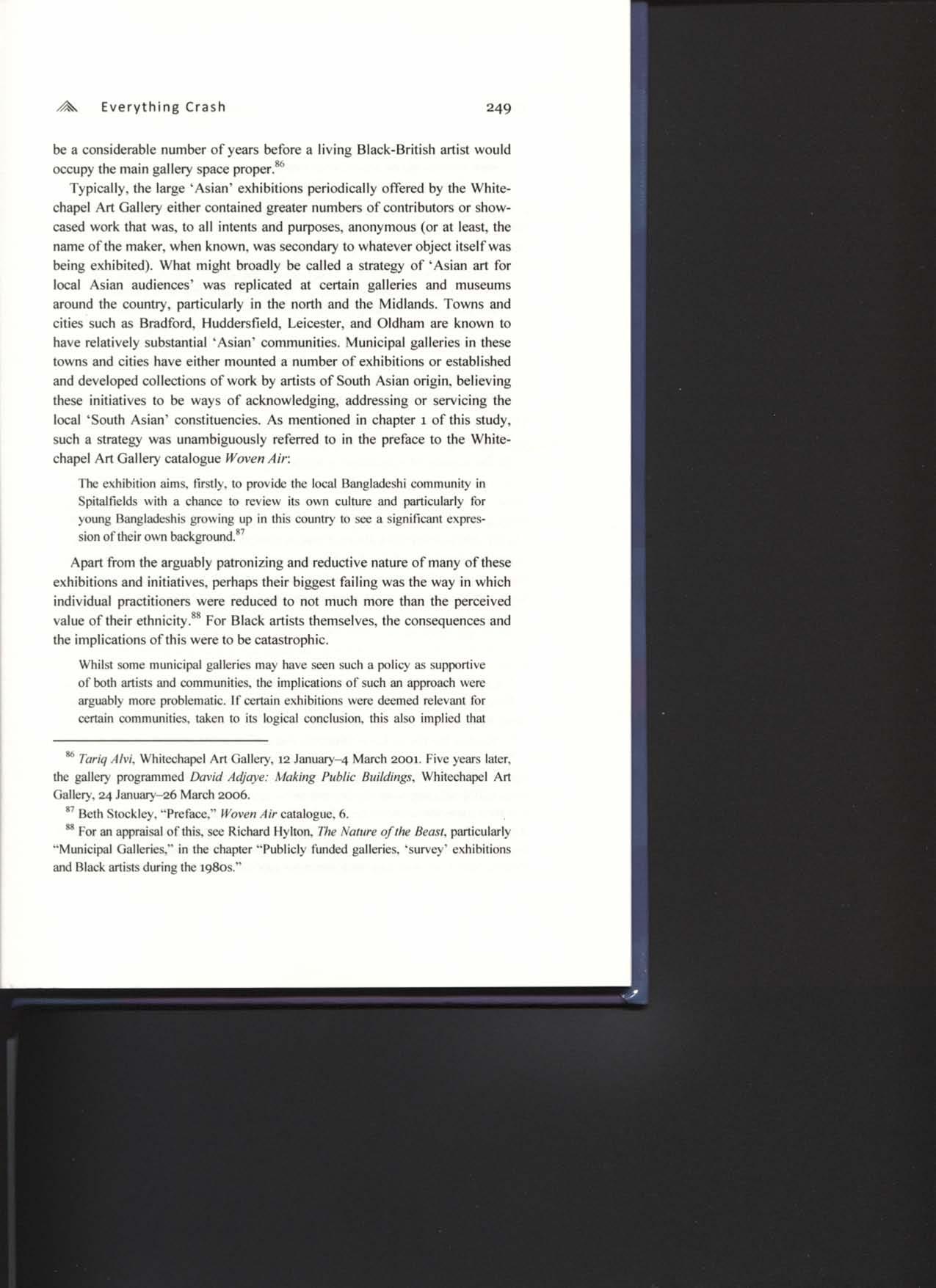
be a considerable number of years before a living Black-British artist would occupy the main gallery space proper.'*'
Typically, the large 'Asian' exhibitions periodically offered by the Whitechapel Art Gallery either contained greater numbers of contributors or showcased work that was, lo all intents and purposes, anonymous (or at least, the name ofthe maker, when known, was secondary to whatever object itself was being exhibited) What might broadly be called a strategy of 'Asian art for local Asian audiences' was replicated at certain galleries and museums around the country-, particularly in the north and the Midlands. Towns and cities such as Bradford, Huddersfield, Leicester, and Oldham are known to have relatively substantial 'Asian' communities. Municipal galleries in these towns and cities have either mounted a number of exhibitions or established and developed collections of work by artists of South Asian origin, believing these initiatives to be ways of acknowledging, addressing or servicing the local 'South Asian' constituencies. As mentioned in chapter 1 of this study, such a strategy was unambiguously referred to in the preface to the Whitechapel Art Gallery catalogue Woven Ait".
The exhibition aims, firstly, to provide the local Bangladeshi community In Spitalficlds with a chance to review its own culture and particularly for young Bangladeshis growing up in this countr)' to see a significant expressionof their own background.*^
Apart from the arguably patronizing and reductive nature of many of these exhibitions and initiatives, perhaps their biggest failing was the way in which individual practitioners were reduced to not much more than the perceived value of their ethnicity."' For Black artists themselves, the consequences and the implications of this were to be catastrophic
Whilst some municipal galleries may have seen such a poliey as supportive of both artists and communities, the implications of such an approach were arguably more problematic If certain exhibitions were deemed relevant for certain communities, taken to its logical etinelusion, this also implied that
71ar/<7 Alvi, Whitechapel Art Gallery; 12Januarj--4 March 2001 Five years later, the gallery programmed David Adjaye: .Making I'ublic Buildings. Whitechapel Art Gallerv' 24 Januar>-26 March 2006
87 Beth Stockley, ""Preface." Woven Air catalogue,6
*" For anappraisal of this, sec Richard Hylton The Nature ofthe Beast, particularly "Municipal Galleries." in the chapter "Publicly funded galleries, "survey" exhibitions and Black artists during the 1980s."
without adiscemible 'ethnic' aimmunity to cater for, the work of Black and Asian artists could be deemed irrelevant to many other (municipal) galleries located incities andtowns acrossBritain.*'*
Perhaps one of the most poignant indications of the lopsided nature of exhibitions such as Krishna The Divine Lover was the final sentence of the latter's news release, which opened thus: Krishna, the legendary Hindu god. has been the subject of song, dance and poctrj for centuries, but it is perhaps through painting that he is celebrated most exuberantly. Marking the fiftieth anniversary of Indian andPakistanIndependence, this exhibition delves into the mythology surrounding Krishna. It draws together around too exquisite miniatures from the sixteenth to the nineteenth centuries. 'Hie exhibition also features new or previously unseen work by Sutapa Biswas. Maqbool Fida llusain. Permindar Kaur. Dhruva Mistry- and Amrit & RabindraK DSingh.""
The final sentence of the news release stated: "Also showing at the Whitechapel during this period is Cathy de Monchaux."
In the manner of substantial adulatory exhibitions of work by dead Black artists, and curatorial product aimed at ethnically specific local audiences. Black artists also had to contend with, and vie with, large and often cumbersome exhibitions that claimed a broad historical sweep Much like the sorts of 'Asian' show mentioned above, these historical exhibitions frequently functioned as signifiers of the London art world's capacity to embrace and demonstrate plurality Again, the Whitechapel .Art Gallery was home to several such exhibitions, which included Seven Stories About Modern Art in Africa '
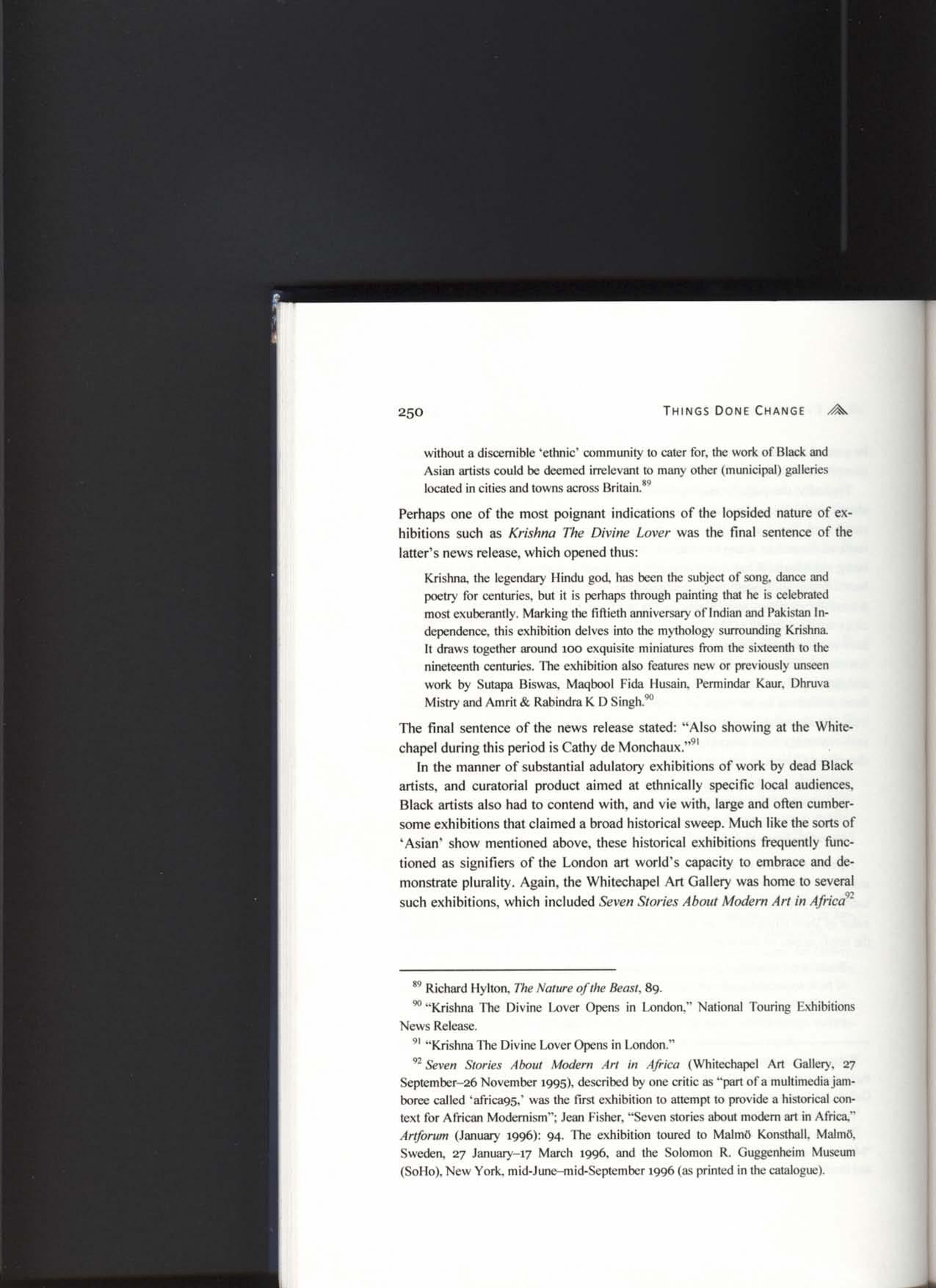
' Richard 1 lylton. The Nature ofthe Beast. 89.
"""Krishna The Divine Ixjver Opens in London," National Touring Exhibitions NewsRelease.
"' "Krishna The Divine Lover Opens in London."
"^ Seven Stories About .Modern Art in Africa (Whitechapel Art Gallery, 27 Septembcr-26 November 1995), described by one critic as"part of amultimediajamboree called "africags," was the first exhibition to attempt to provide a historical context for African Modemism": JeanFisher "Seven stories about modem art in Africa." Arlforum (January 1996); 94 ITie exhibition toured to MalmO Konsthall, MalmO Sweden, 27 January--17 March 1996, and the Solomon R Guggenheim Museum (SoHo),New York, mid-June-mid-September 1996 (asprinted in thecatalogue)
and Back to Black: Art, Cinema and the Racial Imaginary. Such exhibitions followed a familiar structure; numerous artists' work being put together in grandiose curatorial narratives in which individual artist's contributions were largely subordinated to the ambitious themes and frameworks offered by the exhibition's curators and catalogue essay writers The inclination to turn to Black artists when a supposedly relevant festival or commemoration was in the offing was a key factor in the ongoing hemming-in of these artists' aspirations to be seen and accepted as individual practitioners in their own right. Seven Stories About Modern Art in Africa was one ofthe flagship exhibitions of africa [sic] 95 Similarly, Back to Black: Art, Cinema and the Racial Imaginary was one of the flagship exhibitions of Africa 05.*** These africa 95/Africa 05 exhibitions by and large featured the work of Black artists from beyond Britain, though they functioned as signifiers ofthe British art world's impulse towards inclusivity and diversity The most recent of such exhibitions has been Afro Modern: Journeys Through the Black Atlantic, held at Tate Liverpool, 29 January-25 April 2010."** Beyond these bitty exhibitions

"' Back to Black took place at Whitechapel Art Gallery; 7 June-4 September 2005 beforetouring totheNew Art Gallery, Walsall
"* As indicated in Chapter 4 of this study, Africa 05 presented itself a.s"'a scries of major cultural events taking place in London and the rest of the U K that celebrates contemporary and past cultures from across the continent and the diaspora It hasbeen developed by programme director Dr Augustus Casely-Hayford with the aim of raising the profile ofthe huge diversity of African arts and culture hy bringing them into the mainstream and encouraging Britain's arts institutions lo make links with artists from across the African continent and toreachout to African communities here in the UK" (http://www-.tate.0rg.uk/africa05/ (accessed 3 April 2011) Sec also ""AFRICA 05 Partner Activity," IssuedNovember 2004 and"'Plans unveiled for Africa 05 - the UK"sbiggest ever celebration of African cultures." press relea,se issued 18 November 2004 For a critique of Africa 05, see Eddie Chambers, "'[Polemic:] Africa 05," Art Monthly 284 (March 2005): 44 africa (sic) 95, which provided the blueprint for Africa 05.hadCldmcntinc FJclissas its artistic director.
"* Afro Modern: Journeys through Ihe Black Atlantic was"part of Liverpool andthe Black Atlantic, a series of exhibitions and events that explores connections between cultures and continents" (gallery guide) Other exhibitions that coincided with Liverpool and the Black Atlantic included Aubrey Williams: Atlantic Fire (exh cat. 15 January-u April 2010; Liverpool: Walker Art Ciallery 2010) and Sonia Boyce Like Love (Liverprxil: Bluecoat (iallery; 30 January-28 March 2010) Both of theseexhibitions aredealt with elsewhere inthis study.

(bulked out by slender contributions from large numbers of artists) and commemorative programmes such as Abolition 200,"* the vast majority of Black artists found themselves with nowhere to go and nothing to do
During the period of this study, the nature ofthe coverage of Black artists in the British media changed markedly As more and more Black artists found their stock, such as it was, plummeting, a small number of artists, dominated by McQueen, Ofili and Shonibare et al.,concurrently found their stock rising. The latter secured press attention unlike anything that Black artists of previous generations had known. But this coverage had the effect of conveying the message that it was Black artists in general (and not just these few Black artists) who had 'made it'. To some extent, the press coverage secured by Ofiii et al. presupposed, on the reader's part, an understanding of, or familiarity with, these artists' pracfice, thereby leaving them free to indulge their celebrity status. With an artist's pracfice no longer necessarily being the focus of press coverage, it was instead the very success ofthe artist that became the essence of this new type of media attention As discussed in chapter 3 of this study, newspaper or magazine features on Black artists in previous decades, on the rare occasions they appeared, tended to be serious, plodding affairs In all instances, the artist's racial identity and/or the artist's practice were discussed in earnest terms, reflecting the then dominant thinking - as Tony Godfrey put it, "To be an artist was a vocation, a serious, po-faced business." Typical, in this regard, was an interview with Keith Piper that appeared in City Limits in 1984," at the time ofthe artist's solo exhibifion at the BlackArt Gallery."" The two-page interview, conducted by Nigell Pollitt, centred on the asking of questions, by Pollitt, such as "When you talk about the need to create a black visual aesthetic, it sounds as if it's completely separate from white culture. Is that the case?," "Are you saying the black visual arts in this country are behind compared to music?," "But don't you feel the mere presence of black artists, whatever the content of their work, presents athreat, toa
** As mentioned in chapter 2 of this study, Abolition 200 was undertaken with the aim of commemoraling the abolition of the slave trade by the British parliament in 2007-
"'' Tony Godfrey,"British Art andthe British Art Show 1976-2000,"20.
" Nigell Pollitt. "Piper at the gales of dawn. Visual Arts. Circuit: The Cream of the Week," City Limits (6-12 July 1984): 13-14.
** Keith Piper, Past Imperfect. Future Tense, the Black-Art Gallery. 7 June-22 July 1984.
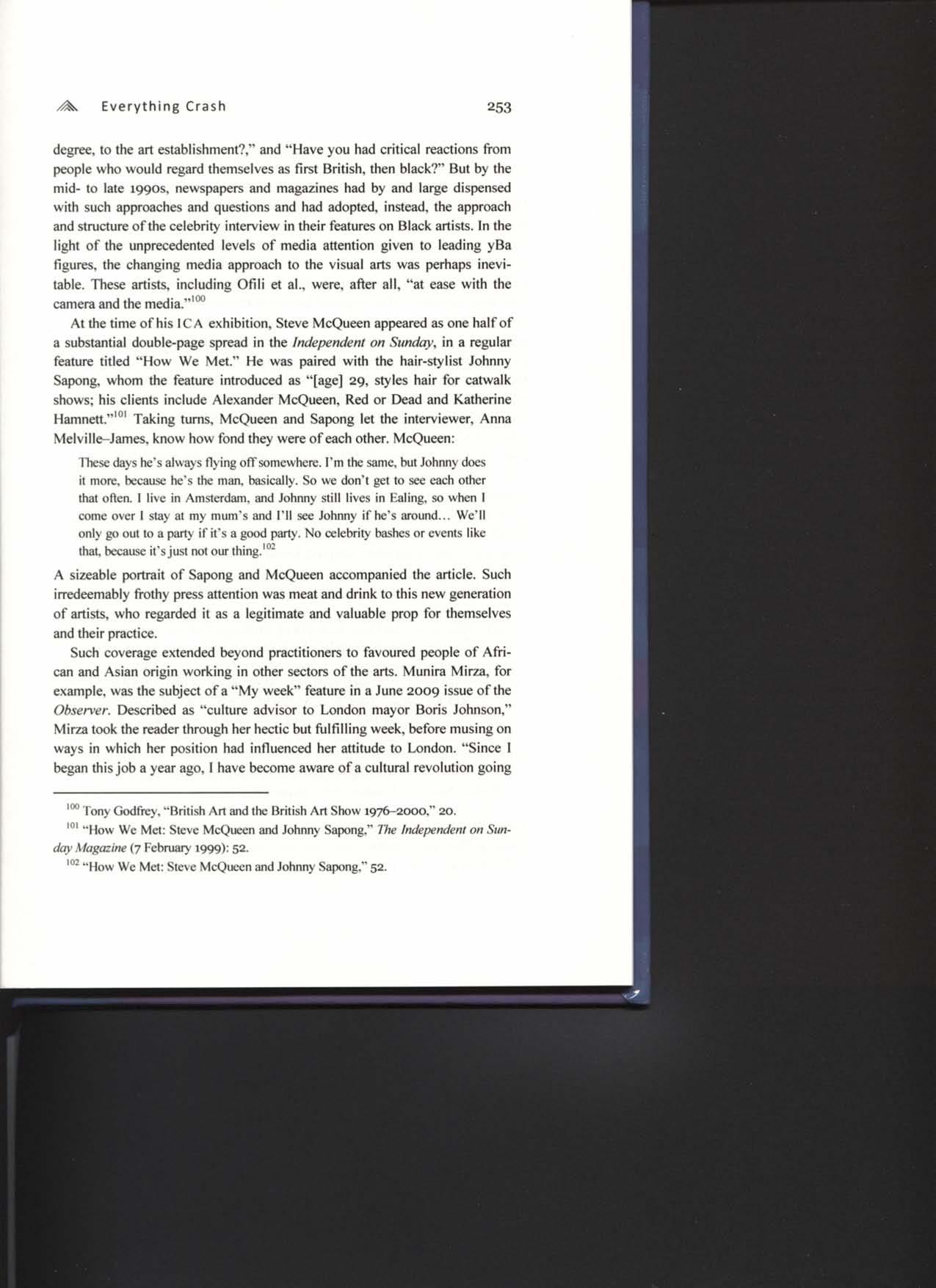
degree, to the art establishment?," and "Have you had critical reactions from people who would regard themselves as first Brifish, then black?" But by the mid- to late 1990s, newspapers and magazines had by and large dispensed with such approaches and questions and had adopted, instead, the approach and structure ofthe celebrity interview in their features on Black artists. In the light of the unprecedented levels of media attention given to leading yBa figures, the changing media approach to the visual arts was perhaps inevitable. These artists, including Ofili et al., were, after all, "at ease with the camera and the media."'***
At the time of his ICA exhibition, Steve McQueen appeared as one half of a substantial double-page spread in the Independent on Sunday, in a regular feature titled "How We Met." He was paired with the hair-stylist Johnny Sapong, whom the feature introduced as "[age] 29, styles hair for catwalk shows; his clients include Alexander McQueen, Red or Dead and Katherine Hamnett."'*' Taking turns, McQueen and Sapong let the interviewer. Anna Melville-James, know how fond they were of each other. McQueen:
These days he's alwaysflyingoft'somewhere. I'm the same, but Johnny does it more, because he's the man, basically. So we don't get to see each other that often. I live in Amsterdam, and Johnny still lives in Ealing, so when1 come over I stay at my mum's and I'll see Johnny if he's around.. We'll only go out to a parly if it's a good party. No celebrity bashes or events like that, because it'sjust not ourthing."*'
A sizeable portrait of Sapong and McQueen accompanied the article. Such irredeemably frothy press attention was meat and drink to this new generation of artists, who regarded it as a legitimate and valuable prop for themselves and their practice.
Such coverage extended beyond practitioners to favoured people of African and Asian origin working in other sectors ofthe arts, Munira Mirza, for example, was the subject of a "My week" feature in a June 2009 issue ofthe Observer, Described as "culture advisor to London mayor Boris Johnson," Mirza took the reader through her hectic but fiilfilling week, before musing on ways in which her position had influenced her attitude to London. "Since 1 began thisjob a year ago. I have become aware of a cultural revolution going
'** Tony Godfrey, "British Art and the British Art Show 1976-2000," 20 "" "How We Met: Steve McQueen and Johnny Sapong." The Independent on Sunday Magazine (7February 1999): 52. 102, How We Met:Steve McQueen and Johnny Sapong," 52.

on inside my own heart." Mirza went on to let the reader know that "I am slowly falling in love with the suburbs."""
Mercer's decidedly upbeat summary of the multiple achievements of Black-British artists had raised some concerns and disquiet about several prominent aspects of the state of Black arts activity."** Mercer had opened his musings by noting posifively that the architect David Adjaye, who had recently held an exhibition at the Whitechapel Art Gallery, was "actually producing three ofthe four new arts centres that will be permanent 'homes' for the black British art scene.""** This comment prompted readers to ponder on the question of which individuals or forces had decided that what Black-British artists needed to thrive and prosper were dedicated (or, some might suggest, segregated) visual-arts spaces. Mercer was perhaps aware ofthe decidedly mixed fortunes ofthe visual-arts building projects initiated in the run-up to the new millennium (and referred to in chapter 2 of this study), because he continued: "am I alone in wondering what exactly is going to go into these buildings and what exactly is going to come out of them?""**' Rosie Millard was to provide some cheerless responses to Mercer's wondering about the precise function of these buildings. In a newspaper feature on the mixed fortunes of building projects, including those Mercer had cited as "'homes' for the black British art scene," Millard oftered a downbeat assessment of these 'homes', including the Bemie Grant Arts Centre, which had "opened in a blaze of hoopla and [was] a building designed by architect David Adjaye." Her report continued:
It was supposed to be a'"flagship for cultural diversity" at acost of £15 million, £6.4 million of which came from the Millennium Fund.On calling this week to find out what was on, the friendly woman at the box office could only guide me to alea dance and avisiting arts troupe Not quite the home of ""nurturing. Inspiration, stimulation and challenge", aspromised on the WCIH siie, and certainly no flagship. Let merepeatthe figures. £15 million for an arts centre otYering two events in the next month,oneof which isa teadance [...] ""Until signage went up... we had no idea what it was... andeven now. we wish the centre's purpose was more clear or somehow tangible."
"**"My Week: Munira Mirza," The Observer (7June2009):38
'** Kobena Mercer,""" Diaspora Didn't Happen inaDay'." 67
'** Mercer, """Diaspora Didn't Happen in a Day'," 66 The three building projects, designed andAdjaye, were the Bemie Grant Centre,the Stephen LawrenceCentre, and Rivington Place,all in London.
'"*""" Dla.spora Didn't Happen inaDay"," 69

writes one bloggcr on the Deptford Dame webpagc. What is it for? Er, education. And something called ""incubator offices" in which businesses arc meant todo something called ""lisc work". No, 1 don't know what that is,and 1don't think Stephen Lawrence's mother Doreen does, either. She's said to bevco unhappy with how things arc."**
Mercer wondered if the impetus for these assorted building projects, dominated by Rivington Place, the combined home of INIVA and Autograph (the Association of Black Photographers), had gathered momentum just when the fortunes and profile of Black-Brifish artists had begun to fade dramatically:
To raise such doubts is observe |sie] that the cureent black British art scene hasreachedsomething of a plateau in the period between 2000 and 2005 The driving energies of its creative ambition actually began to level oft", in my view, some time ago at some point in the late 1990s Against this backdrop, the complex question of Institution-building is underlined by the double-sided connotations of its cognate tcmi: jnstitutionalisation On the one hand, without museums, collcetions, and institutions to preserve the materials of sharedcultural history the past Isvulnerable to selective erasure - a symbolic threat that the cultures ofthe Black Atlantic diaspora have had tocontend with from their Inception Onthe other hand,there isthe appalling dystopian risk that Adjaye's beautiful buildings might somehow end up "empty" if there is insutTicicnt passion for genuine public dialogue, debate, and disagreement about the overall '"direction"- or rather ""directions" in the plural - that theblaek British arts .sceneistaking asawhole."*"
Although Mercer had. earlier, erroneously stated that Ofili had won the Turner Prize in 2002 (the correct year being 1998), he nonetheless suggested that the successes of McQueen, Ofili, and Shonibare, which began in earnest in the late 1990s, coincided with the beginnings of a questionable institutionalization of the Black-British artist Put in these sobering terms, Mercer's doubts underlined the degree to which Ofili et al were going in one direction, while the bulk of Black-British artists were, or at least had the appearance of, moving in a conceivably less favourable direction Perhaps mindful ofthe extent to which these two directions indicated Black artists' decidedly mixed fortunes, Mercer plumped for "it may well be the case that the black British arts scene is flourishing and floundering in equal measure,"
"*' Rosie Millard, ""Money for nothing," 14.
"*" Mercer,"""Diaspora Didn't Happen in aDay"." 69, 109 '' Diaspora Didn't Happen in aDay',"' 69.

In seeking to evaluate the mixed fortunes of Black-British artists of the late-twentieth and early-twenty-first centuries, it is important to recall that "the black British arts scene extends back across the twentieth century as a whole.""" Collectively and individually, Black-British artists have, over an extended period of time, had notable moments of success and achievement. The decade ofthe 1950s can be identified as a particularly significant one for the pioneering generation of Black artists in London, According to Leslie Primo,
These early pioneers of black British art [Frank Bowling and Aubrey Williams] would eventually berecognized,post-millennium, by the mainstream art establishment for their contribution to the British art scene: however, black British artists would not again experience the heady days of the 1950s.'"
Notwithstanding Prime's characterization of the 1950s as a pivotal decade and Bowling's disillusionment regarding the period, in the early 1960s Bowling and Williams both had significant and important solo exhibitions at London galleries, as well as showing in equally important group exhibitions in which their practice was appraised alongside that of their white colleagues.''" Later, in an altogether different space and time, thirteen London-based Black artists had exhibited together at Feslac 77, the 2nd World Black & African Festival of Arts and Culture, held in Lagos Nigeria in 1977-'" Within several
"" Mercer, "' Diaspora Didn't Happen ina Day'," 69.
"' Leslie Primo, "Visual Arts 2: Artists. 2 Guyanese Artists," in The Oxford Companion to Black British History, ed David Dabydeen, John Gilmorc & Cecily Jones (Oxford &New York: Oxford U P,2007):502.
"M^orexample, both ofthese artists had several important exhibitions atGrabowski Gallery in London in the early 1960s. Frank Bowling and Derek Basliier. Image in Revolt, 5Octobcr-3 November 1962: Aubrey Wiliiams, 3-24 Januar>; 1963 Although Frank Bowling felt that he had been unjustly excluded from the 1964 New Generation exhibition at the Whitechapel (see In the Citadel of Modernism, The Other Story catalogue, 1989, 40), Aubrey Williams was included in .ippointment With Six: International Abstract Trends, Aran Arts Centre, 19October-5 November 1966. Alongwith Williams, the exhibition included Owen Bamard, Pip Benveniste, Oswell Blakeslon. Max Chapman, and A Oscar In 1962, the Arts Council Collection obtained one of Bowling's paintings ("Birthday," 1962,oil on canva.s. 121.9 x 91.4cm), making itone ofthe first worksbya Black-British artist to bethus acquired.
'"in 1977, a group of Iz)ndon-based Black artists exhibited at Feslac'77. an international festival of arts and culture from the Black world and the Afi-lcan Diaspora
years of this, a new generafion of Black-British artists had emerged and their energies were coalescing around shows such as Five Black Women Artists at the Africa Centre, Black Woman Time Now, and the Creation for Liberation exhibifions,"* Looking back at the astonishing history of Black-British visual-arts practice, we could argue that its most pronounced moments of achievement have involved artists themselves, initiating their own projects, with little or no regard for state funding, which by its nature often consigns what it touches to failure, disappointment, or a disempowering and moribund existence
Change characterized the emergence of the 1980s generation of Black artists, just as much as (or no less than) change characterized the emergence of a core group of favoured artists during the 1990s This point is of great consequence because whatever was 'new' about the second generation of Black-British artists did not stay 'new' for long. Once the art establishment had 'discovered' Black artists, via the survey shows discussed in this study, their 'newness' quickly evaporated, leaving instead a few artists who were discussed and related to with an almost suffocating, though ultimately hollow, familiarity. The art establishment was able to rapidly assimilate the 'new', making it the 'familiar'. It was perhaps this process of assimilation that Keith
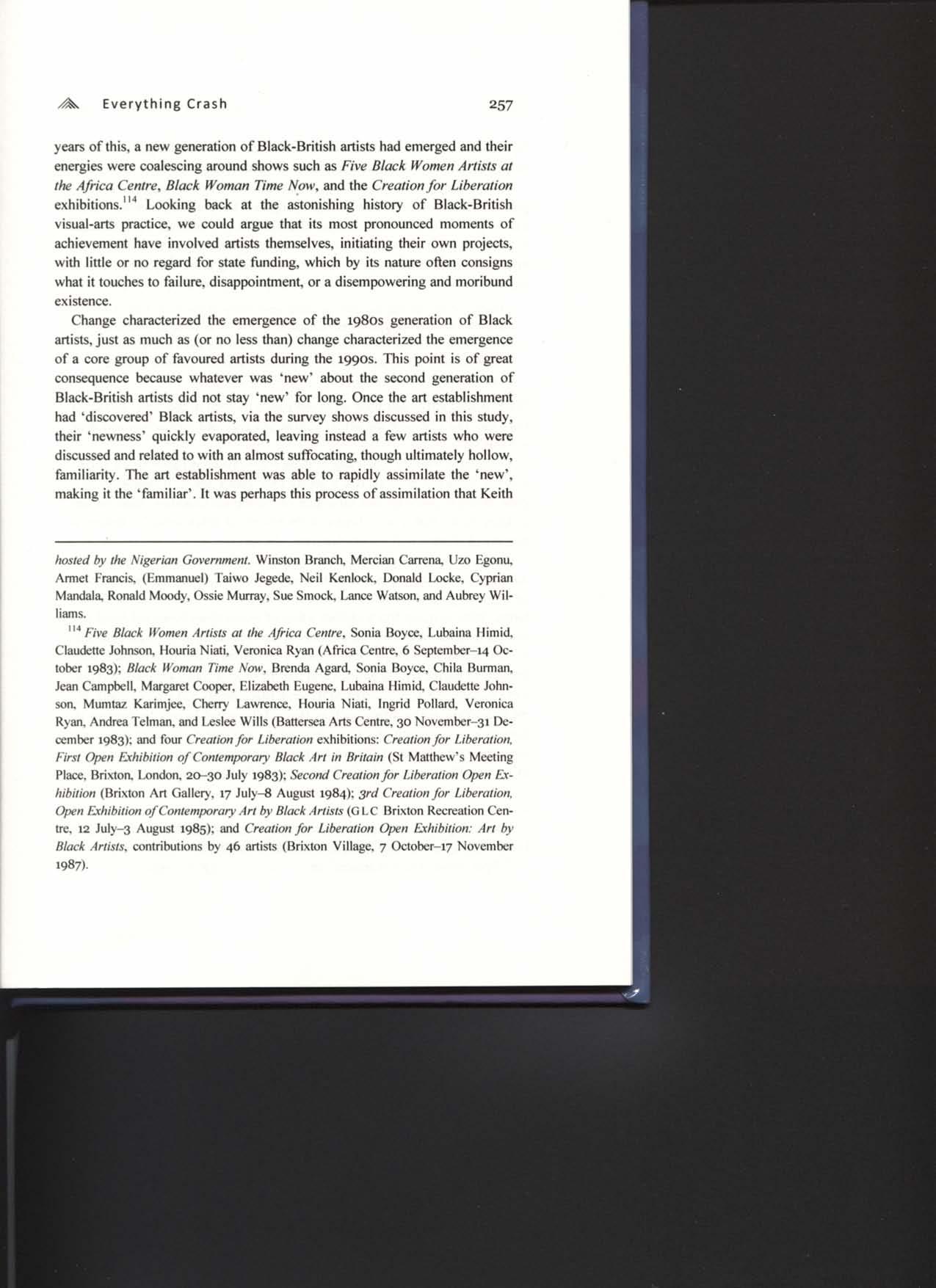
hosted by the Nigerian Government. Winston Branch, Mercian Cairena, IJ/.o F/gonu, Amei Francis, (Emmanuel) laiwo Jegede, Neil Kenlock Donald Locke Cyprian Mandala Ronald MoiKiy, Ossie Mureay, SueSmocL Lance Watson,and Aubrey Williams.
"* Five Black Women Artists at Ihe Africa Centre, Sonia Boyce, Lubaina Himid. Claudette Johnson, Houria Niati. Veronica Ryan (Africa Centre. 6 Septcmber-14 October 1983): Black Woman Time Now, Brenda Agard, Sonia Boycc, Chlla Burrnan, Jean Campbell, Margaret Cooper Elizabeth Eugene, Lubaina Himid Claudette Johnson, Mumtaz Karimjee, Cherry Lawrence, Houria Niati, Ingrld Pollard, Veronica Ryan, Andrea Telman,and Leslee Wills (BatterseaArts Centre,30 Novcmbcr-31 December 1983): and four Creation for Liberation exhibitions: Creation for Liberation, First Open Exhibition of Contemporary Black Art in Britain (St Matthew's Meeting Place, Brixton, london, 20-30 July 1983): .Second Creation for Liberation Open Exhibition (Brixton Art Ciallerv; 17 July-8 August 1984): 3rd Creation for Liberation, Open Exhibition of Contemporary Art by Black Artists (GLC Brixton Recreation Centre 12 July-3 August 1985): and Creation for Liberation 0/?en Exhibition: Art by Black Artists, contributions by 46 artists (Brixton Village, 7 October-i7 November 1987).
Piper meant when he wrote, in 1987, that "some of us would argue that Black Art, like Brixton, is undergoing a period of'gentrification'.""*
Piper's view of this 'gentrification' navigates several readings ofthe emergence of Black visual artists in 1980s Britain. The first reading was that artists in general and, in this instance Black artists in particular were reluctant to see themselves as building on whatever had gone before them. They were instead inclined to regard whatever they were doing as an emphatic, refreshing and belter departure from whatever had gone before To quote Piper:
History shows us that the Arts, or more specifically in this case 'Fine Art', unlike (the) Sciences, holds too antagonistic a view of itself to effectively build upim what has gone before. Preceding events arc more often than not reacted against, denigratedaspasse,or parodied askitsch. Becauseof thisart changesrather thanadvances."*
Black-British artists and their art in the 1980s ushered in the 'new' (different from the 'old') because the artists themselves regarded themselves and their work as such
Concurrent with the sidelining of those most-favoured 1980s Black artists, a newly favoured body of Black artists took centre stage If change is to a great extent a given, an inevitable part ofthe human condition, then we can perhaps expect that a new chapter in the history of Black artists in Britain, a new era of change, will sooner or later - be upon us
Again, looking back at the recent history of Black artists in Britain, it is difficult, though not impossible, to imagine individual artists, or groups of artists, emerging at points in the ftiture, on pronounced counter-cultural platforms With so many Black-British artists of recent times being sidelined and the rest institutionalized by the honours system and an establishment embrace, the conditions are perhaps right for new generations of artists to emerge, with little or no regard for either art-world indifference or those separate-development initiatives ostensibly created to serve Black artists and Black people. By the late-igyos, major artists such as Henry Moore had largely become an irrelevance to a generation of younger artists, anxious to develop their own practices with a breezy disregard for the art-establishment hegemony typified by Moore Fleetingly, art in the Punk years had a dynamism that owed much
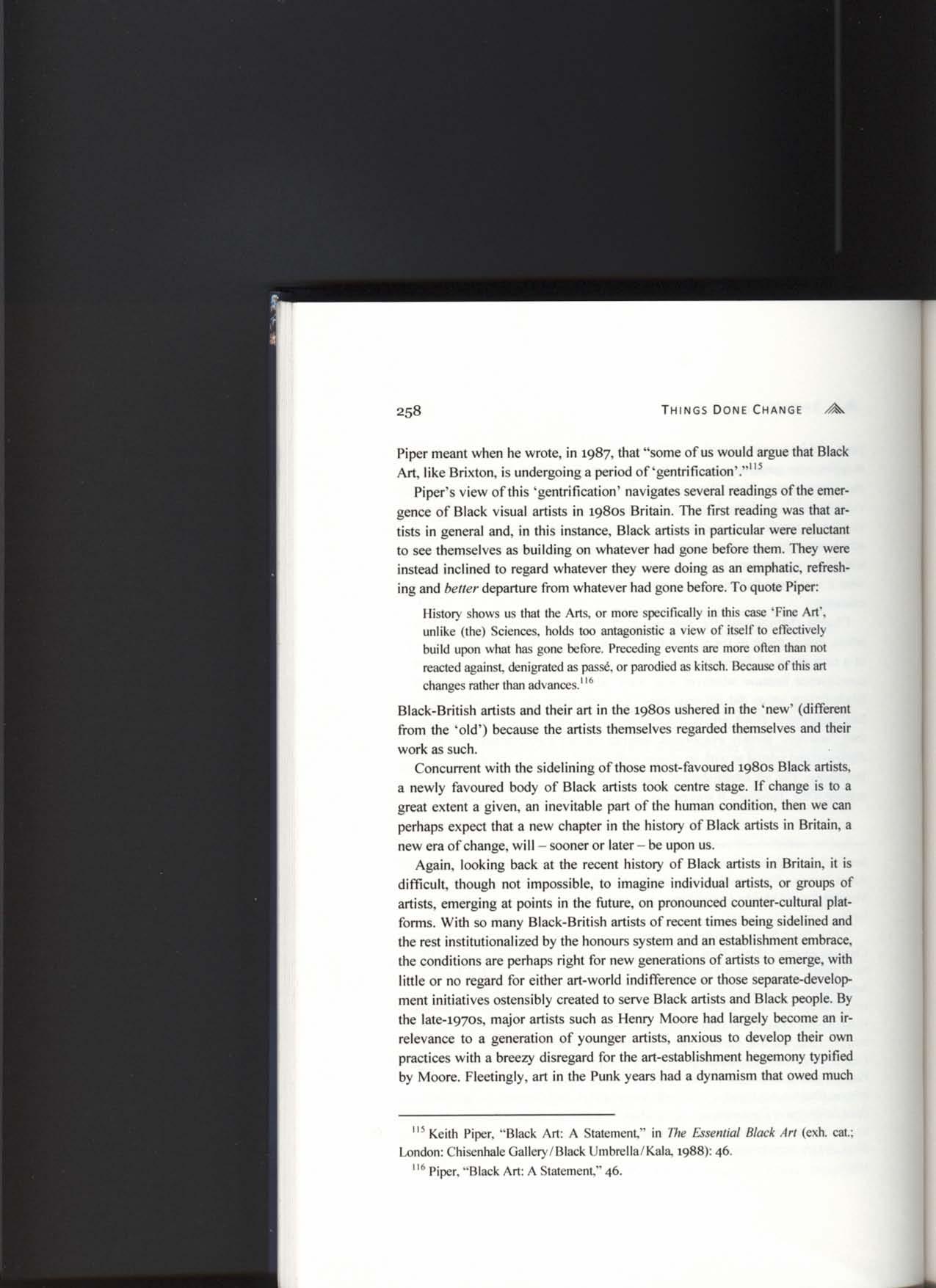
''* Keith Piper "Black Art: A Statement." in 77ie Essential Black Art (exh cat.: London: ChisenhaleGallcrx /Black Umbrella/Kala, 1988):46
"* Piper. "Black Art: A Statement," 46,
to its counter-cultural sensibility."^ The rapid ascendancy ofthe dominant personalities discussed in this study, artists such as Ofili and Shonibare, suggests that they are on their way to becoming the Henry Moores of our time - establishment, successful, but quite possibly less than relevant to upcoming generations of artists keen to make their own mark

' See, for example. Panic Attack: Art in tlie Punk Years (exh. cat.. Barbican Art fiallerx; London: Mcrrell, 2007) See also John A Walker, Left Shift: Radical An in 1970s Britain (Ixmdon:I.B. Tauris, 2001).